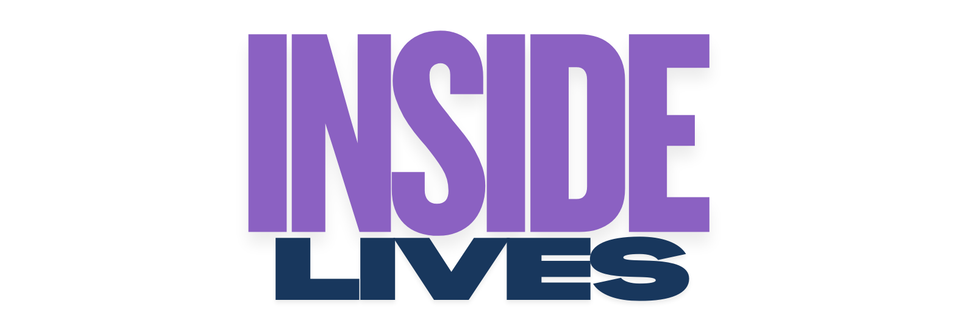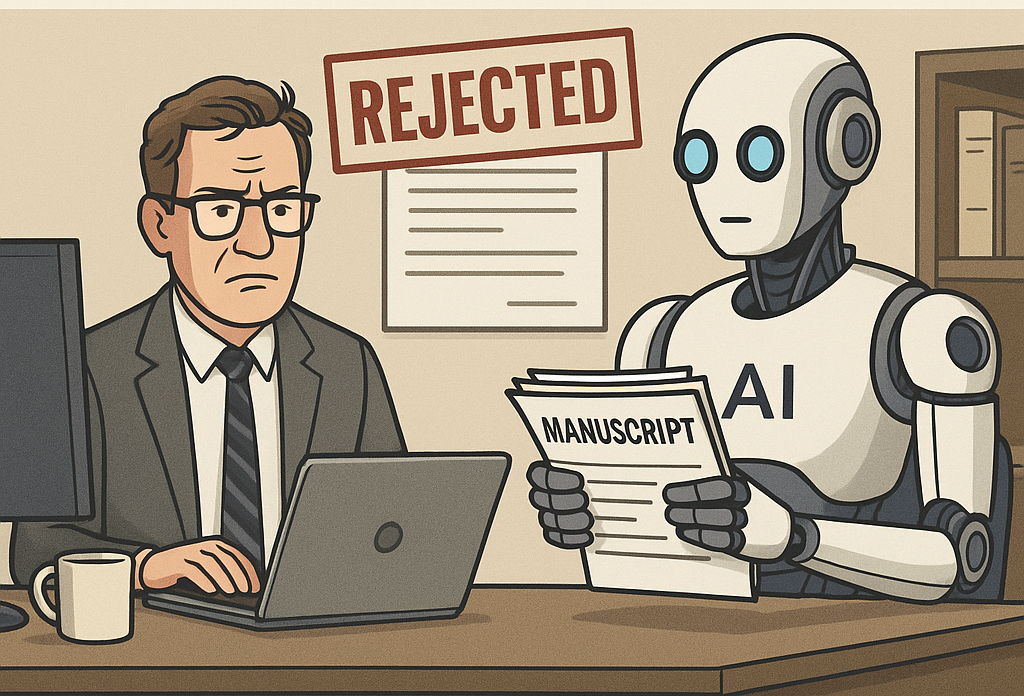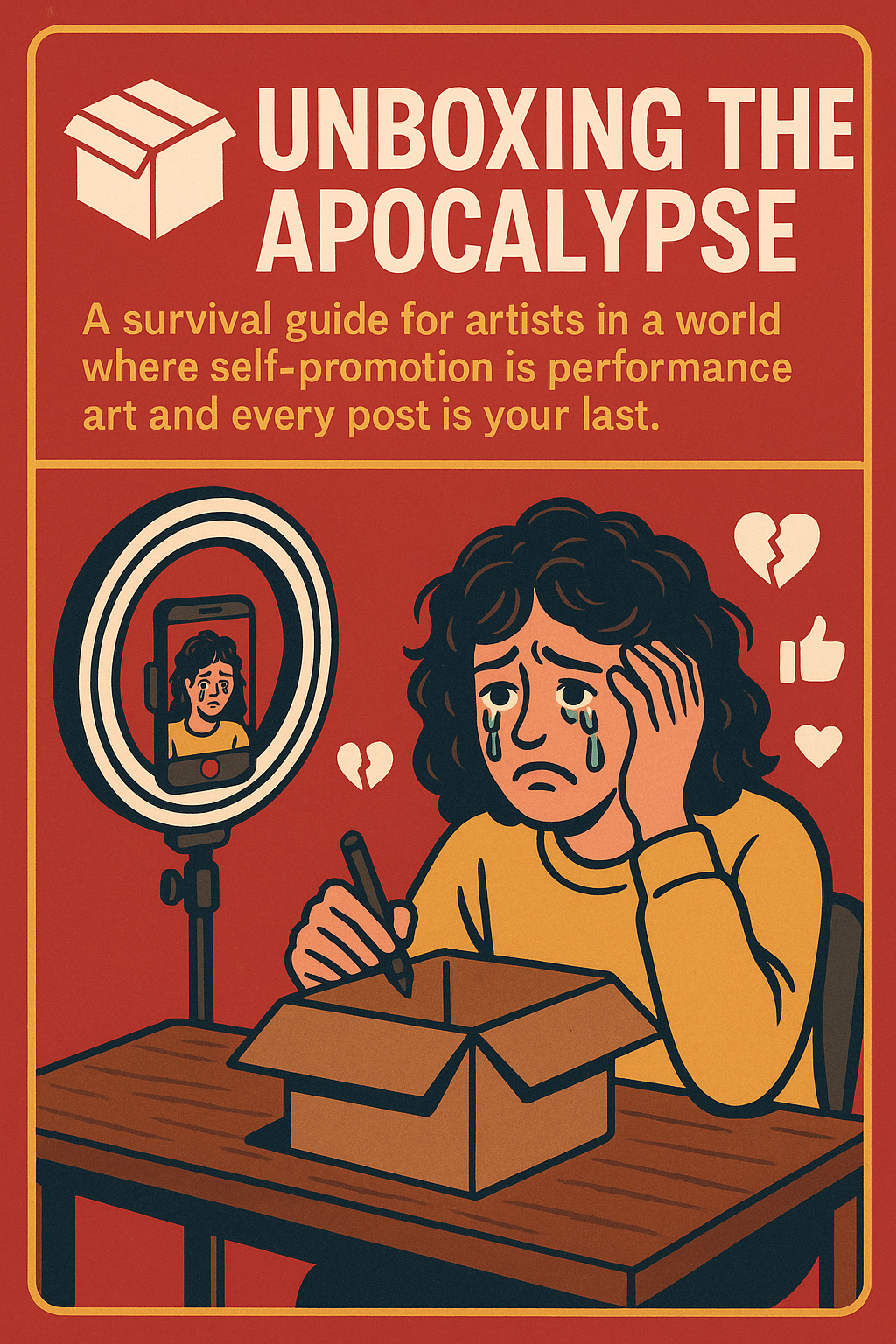👽 Norwegian Cultural Policy Explained with Alien Memes
A surreal yet honest tour through Norway’s publicly funded cultural sector — as seen through the eyes of a bureaucratically curious alien. Yes, this is real. Yes, it’s state-funded. Yes, there are spreadsheets involved.
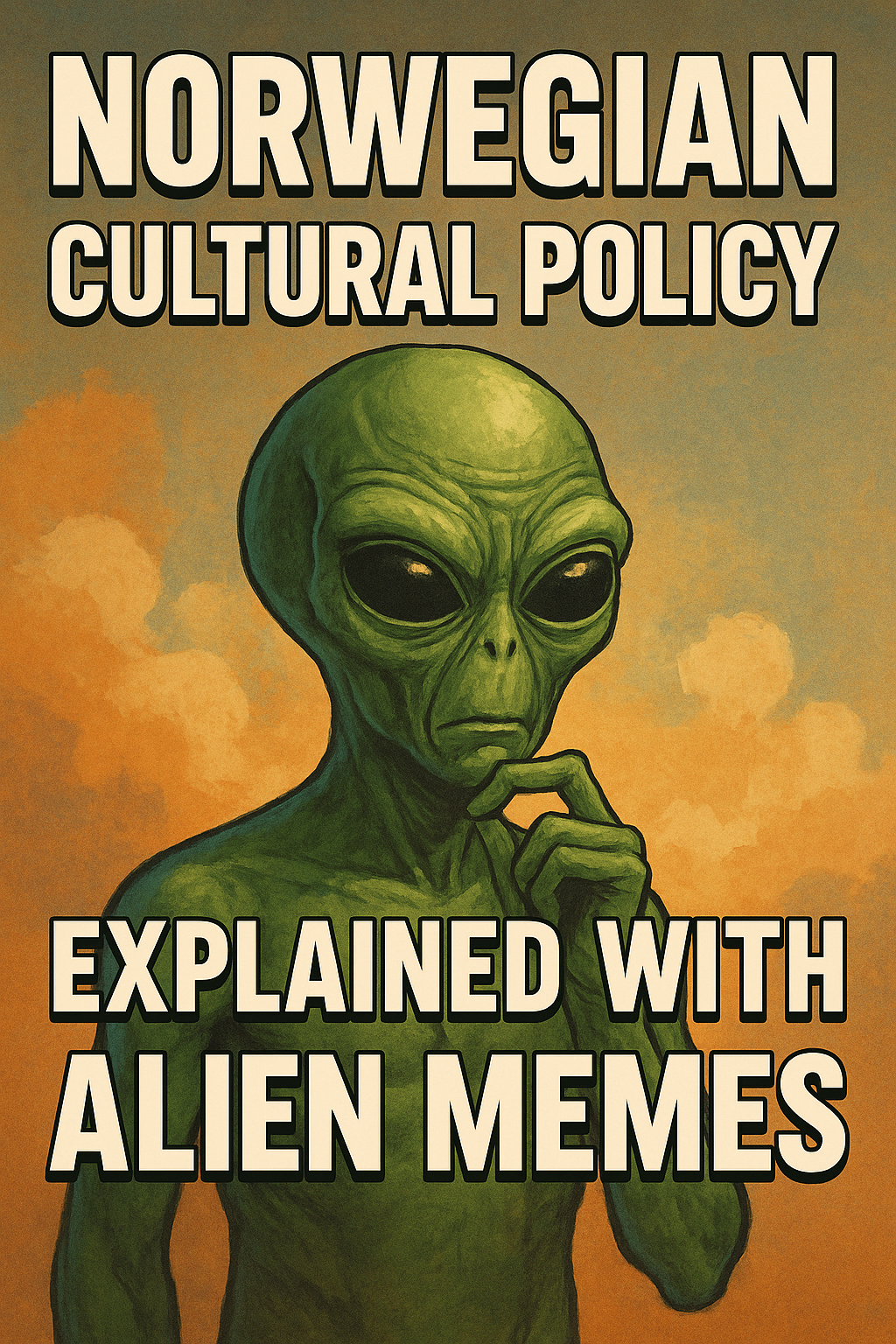
🛸 Transmission Begins
To: Galactic Research Directorate, Sector V–Arbiter of Civilizational Intelligence
From: Intergalactic Department of Anthropological Confusion
Re: Cultural Priority Mapping Report – Planet Earth, Subzone: NORWEGIA
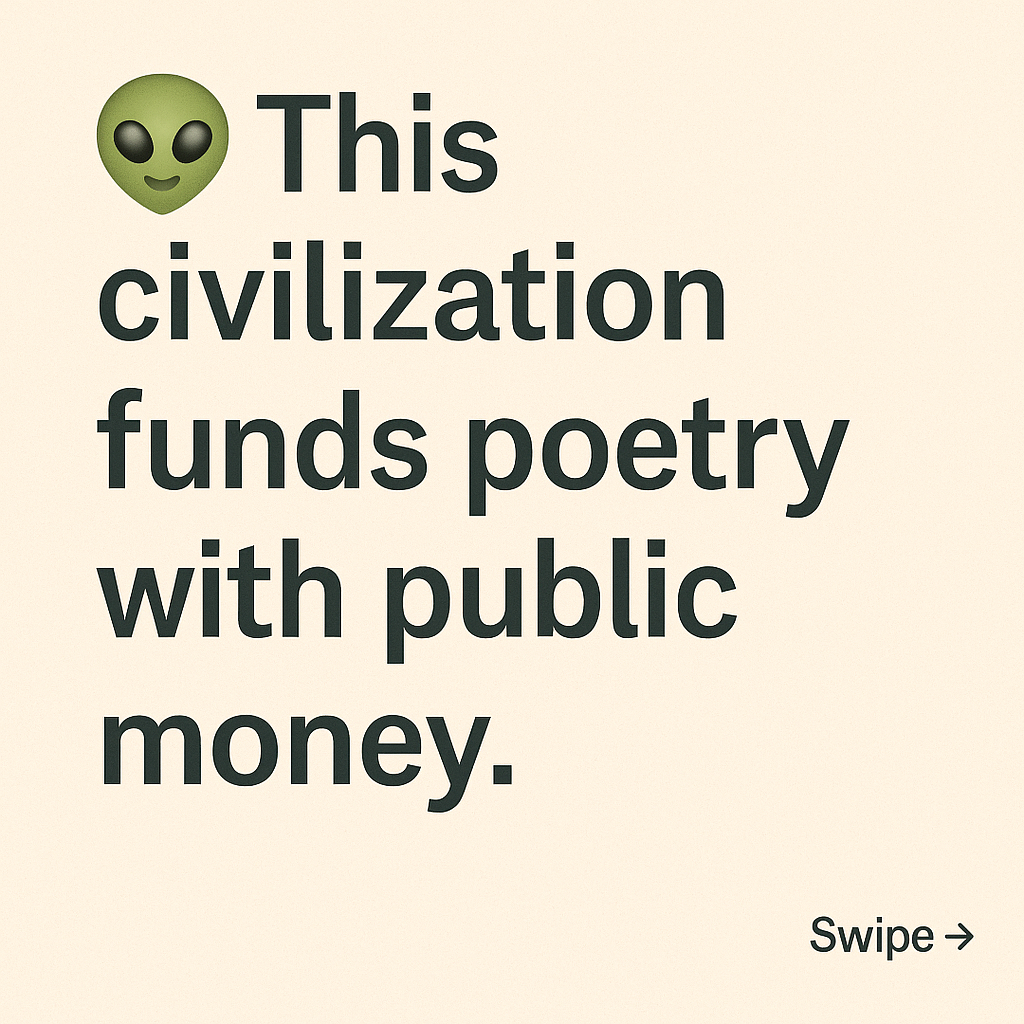
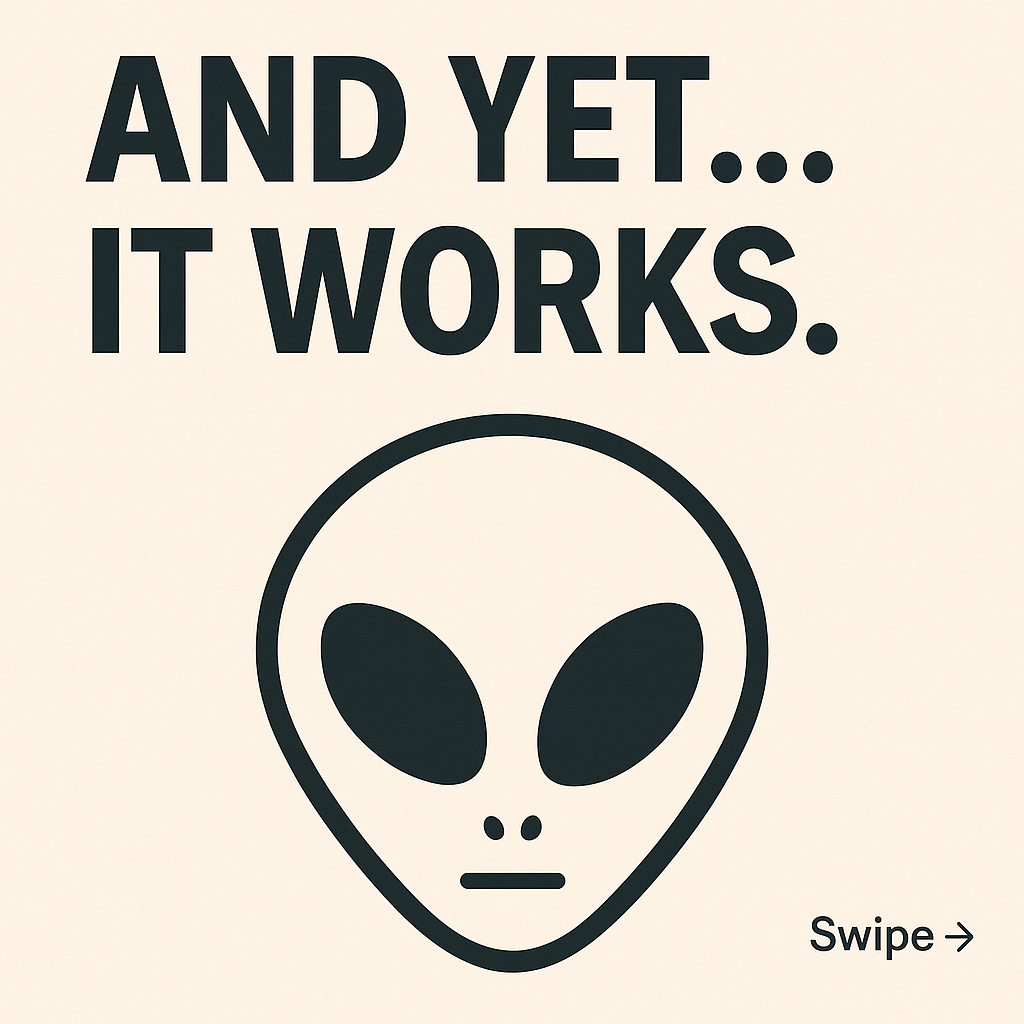
“For further orientation: this is approximately what they think we look like.
We have completed our seventh observational pass over the Northern Continental Outgrowth known locally as Norway. Our mission was simple: determine what this civilization values by examining how it spends its public currency. We began, as instructed, with the digital parchments stored under their “State Budget” interface. The document was 694 pages long and color-coded. Our linguistics assistant passed out after page 3.
Upon regaining consciousness, we determined that a full 0.83% of this nation’s annual planetary treasure — referred to in the Earth dialect as “the national budget” — is allocated not to weapons, food, or weather control, but to cultural rituals. This equates to 25.8 billion NOK, or roughly the cost of building 6.5 new interstellar transport portals (at Union-standard safety compliance). These funds are not hidden or contested. They are not demanded at spearpoint. They are printed in large, triumphant fonts by the government itself and distributed to the people in .pdf form.
At first, we feared we were witnessing the early signs of a terminal group delusion. But the pattern persisted across multiple fiscal cycles — including during the planetary pandemic, when they actually increased funding for interpretive dance. This led us to a shocking conclusion:
The Norwegians have institutionalized meaning.
They have developed a government-funded metaphysical scaffolding in which humans are paid — handsomely — to simulate shared experience through sound, gesture, and archival object collection. They do this annually. They justify it using dense paperwork. They explain it to each other using PowerPoint slides and a recurring slogan about “cultural democracy.”
They call this system cultural policy.

Earthlings and Their Symbolic Resource Allocation
Culture, in most planetary settlements, is an emergent property — the result of social friction, sexual tension, and generational disappointment. But in Norway, it has been systematized, bureaucratized, and financed. One may even request public compensation for failing to complete a poem, provided the application is properly submitted and co-signed by three recognized experts in sadness.
The Norwegian state divides culture into sub-rations using a variety of sacred institutions:
- The Ministry of Culture and Equality – the central command node
- Arts Council Norway (Kulturdirektoratet) – the ritual-disbursement council
- KORO – a unit responsible for injecting visual metaphors into municipal stairwells
- Sametinget – the indigenous sovereign zone, independently running its own emotional infrastructure
Together, these form a symbolic economy where culture is not a byproduct of society, but a line item in its design. Funding is distributed according to parameters that are both noble and nonsensical. A national theatre receives 750 million NOK for embodying grief on stage. A folk music duo in a fishing town receives 18,000 NOK to compose sea shanties in memory of a retiring lighthouse. Both are considered national priorities.
This is not satire. This is fiscal reality.
The Origins of the Cult (A Brief Timeline)
Our analysts have traced the expansion of this belief system to a period known as Kulturløftet — or, “The Cultural Lift.” Initiated in 2005, it marked a political decision to treat the arts not as decoration but as infrastructure. During this era, cultural spending nearly doubled, and grand temples were constructed to house Norwegian expressions of excellence: a new opera house, a national museum, a literature distribution mechanism that buys 1,000 copies of every published book, even if nobody reads them. This is, to our knowledge, unique among known sapient species.
Other civilizations have state-funded art. Few operate as though culture is a national immune system.
The financial architecture has grown elaborate:
- Municipalities offer micro-funding to “youth arts clusters” (small gangs of theater-adjacent adolescents)
- National funds support “expressions of digital creativity”
- Independent musicians may apply for stipends based on artistic vision, genre clarity, and whether they can write a two-page essay about inclusion
This has produced an entire caste of highly trained applicants — humans who can translate desire, identity, and theoretical audience reach into Excel-compatible terminology. They worship the god of Application Forms. They measure transcendence using KPIs.
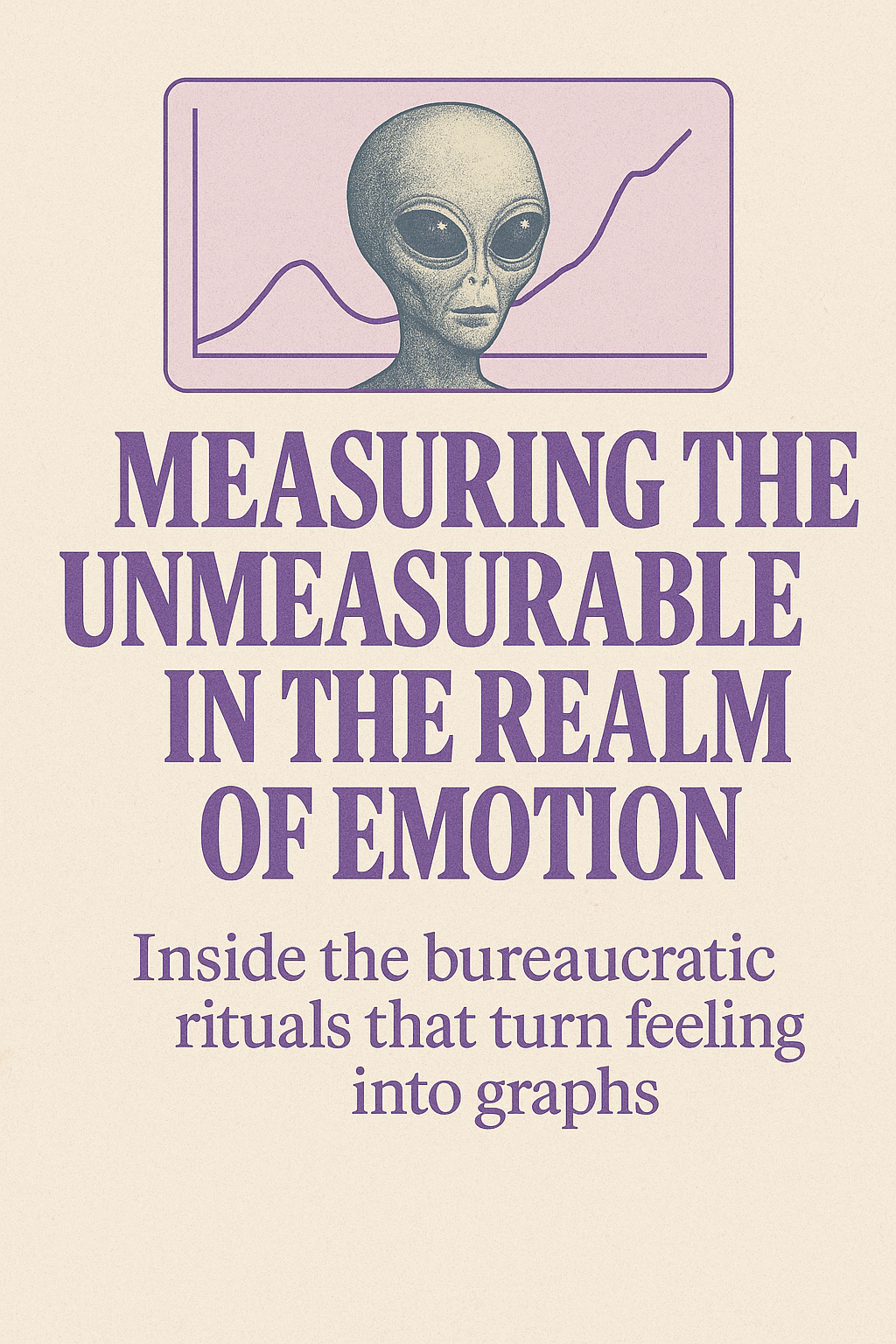
First Impressions: Emotional Engineering as Policy
To understand what this society values, we tracked the distribution of cultural offerings:
- Opera receives more than any other ritual artform (it is unclear whether this is because the Norwegians enjoy it, or because they believe it is the correct behavior of an advanced society)
- Freelance artists are paid monthly stipends to explore emotion professionally
- Sámi cultural organizations receive earmarked support, including for joik, a traditional vocal style that doubles as personal sonic biography
- Video games are increasingly subsidized, as youth now perform most of their existential crises via controller
- Festivals are viewed as holy sites, to be funded, surveyed, and occasionally cancelled when clouds become inconvenient
From the outside, it appears that Norway believes a stable society must be saturated with metaphor — state-distributed, publicly evaluated, regionally accessible metaphor.
To some members of our team, this was deeply moving.
To others, it was symptomatic of a species that has grown bored with survival and now simulates emotional necessity using taxpayers.
Working Hypothesis
Based on our initial scans, we believe the following:
Norway has created a civilization where art is not performance, but infrastructure.
Their systems reward both excellence and effort. They fund critique of themselves. They pay for confusion if it is well-phrased. Their poets are salaried. Their archives are fortified. Their theatres are full of existential screams arranged harmonically in marble halls. This is considered optimal use of surplus energy.
And so we submit this report — part field guide, part misinterpretation, part genuine admiration.
We will proceed to analyze this cultural economy through the only lens available to us: a deeply confused, but well-meaning, alien perspective.
May this document serve both as a warning and an example. For if Earth is to be understood, it must first be narrated.
And in Norway, narration is a funded activity.
🧭 EXECUTIVE OVERVIEW
The humanoid zone known as NORWEGIA exhibits a highly developed fiscal terrain wherein symbolic expression is subsidized as a civic utility. This is achieved through a multi-tiered structure of budget rituals, ceremonial allocations, and application-based veneration rites.
The system appears to believe that emotion is infrastructure, and thus must be financed accordingly
PRIMARY OFFERING FLOWS.
| Funnel | Administered by | Total Offerings (NOK) | Alien Misreading |
|---|---|---|---|
| Kulturdepartementet (Ministry of Culture) | Parliament / National Council | ~26.8 billion | Supreme priests determine emotional taxation levels annually |
| Kulturrådet (Arts Council Norway) | Arm’s-length semi-autonomous body | ~1.1 billion | Mid-level acolytes allocate joy-units to the faithful |
| KORO (Public Art Norway) | Under the Directorate for Culture | ~100 million | Statues are deployed as territorial emotive markers |
| Sametinget Kulturmidler | Sámi Parliament | ~150 million (culture-specific) | Tribal memory preservation pods receive annual blessing |
| Municipal and County Budgets | 356 municipalities, 11 counties | ~7.4 billion | Local elders fund barn concerts and cross-country choreography |
| EU/EEA Contributions & Grants | Via Creative Europe, Erasmus+, etc. | Variable | Interplanetary allies exchange symbolic tokens for solidarity |
In Earth cultures, the movement of public currency is typically a grim process involving roads, tanks, and the medically underfunded. Norway, however, channels a significant portion of its treasure — 25.8 billion NOK in 2025 — into the cultivation of metaphor. This is not a one-time splurge. This is structural. Institutional. Repeated annually with pride and footnotes.
The Earthlings in this sector describe the process as “the cultural budget.” But from a systems-analysis standpoint, what we are witnessing is better understood as a state-sponsored conversion ritual: raw capital becomes symbolic infrastructure.
This part of the report attempts to chart that conversion.
We followed the money.
We did not return unchanged.
Who Funds the Metaphor?
THE COUNCIL OF MANY TIERS
The Offering — as we’ve come to call it — is not delivered by a single high priest. Rather, it is dispersed across multiple layers of overlapping government units, each with slightly different robes, responsibilities, and institutional fonts.
🏛️ Tier One: The Ministry of Culture and Equality (Kulturdepartementet)
The central command node of the metaphor machine. This ministry, part of the Norwegian government, proposes a national culture budget each year — subject to parliamentary approval. In 2025, it received 25.8 billion NOK for its operations. This figure includes funding for:
- National cultural institutions (museums, theatres, archives)
- Artist stipends and grants
- Film and media development
- Libraries and literature programs
- Inclusion and diversity initiatives
- The occasional public festival involving 200 local schoolchildren and an inflatable elk
While most Earth governments treat culture as a discretionary expense — funded if the tanks are full — Norway has embedded it directly into the national financial circulatory system. There are no tanks. There are string quartets.
“The Norwegians appoint a Minister to ensure no citizen forgets their symbolic self. This Minister may not control war, but they control memory.”
🏘️ Tier Two: Local Governments
Norwegian municipalities and counties play an equally fervent role in the Offering. In fact, nearly half of total cultural funding comes from these lower-tier units. Their duties include:
- Running public libraries (nearly 800 of them — one in almost every town)
- Operating cultural schools (where children are trained in flute, jazz, and regret)
- Supporting regional theaters and museums
- Funding local festivals, artist residencies, and amateur choirs
- Co-funding major institutions with the state (e.g. symphonies, folk museums, regional archives)
Some towns support marching bands of 12-year-olds with budgets larger than their road maintenance department. One fishing village reportedly spent municipal funds to sponsor a three-day accordion summit on a fjordside plateau. No one questioned it.
“Each sub-tribe has the right to sustain its own localized metaphors. This prevents civil collapse.”
🛑 CONTRADICTIONS OBSERVED IN THE TOPOGRAPHY
- Vertical Power, Horizontal Justification
Funds are allocated top-down, but all decisions are cloaked in grassroots rhetoric. - Predictability vs. Precarity
Institutions receive long-term stability; individuals compete in seasonal lotteries. - Wealth of Forms, Poverty of Time
Cultural workers receive offerings—but must sacrifice months at the altar of paperwork.
🎰 Tier Three: Lottery Funds (Spillemidler)
In a structural curiosity, Norwegian gambling profits are partially redirected to culture. The state-owned Norsk Tipping lottery delivers about 18% of its surplus to cultural and youth projects. These funds support:
- Frifond (youth music and arts initiatives)
- Infrastructure for cultural buildings
- Pilot projects for inclusion or innovation
This ritual gambling-to-culture mechanism may appear trivial, but it contributes hundreds of millions annually to the symbolic economy.
“Humans wager on meaningless outcomes, then offer the winnings to poetry. A cyclical justice.”
🧭 Tier Four: EEA and EU Participation
Though not a member of the European Union, Norway contributes to — and receives from — various cultural initiatives via the European Economic Area (EEA). Norwegian entities apply for:
- Creative Europe grants
- Cross-border art exchanges
- Cultural diplomacy through embassies and national days
And in a geopolitical twist, Norway itself distributes EEA Grants to fund culture in other countries (e.g. Roma theater projects in Slovakia). It does this for…reasons.
“They fund art across borders to gain symbolic influence, or possibly to export surplus metaphor to prevent overload.”
Who Receives the Offerings?
The receiving end of the Offering is not a single altar, but a sprawling network of institutions, ensembles, collectives, individuals, and systems. They are organized by the type of emotion they aim to generate or preserve.
We break them down as follows:
Note: Estimates vary depending on how the funding is counted (state vs total public vs project vs institutional).
Case Study: Oslo Opera vs Indie Choral Quartet
To illustrate the disparity within the Offering:
- The Norwegian National Opera & Ballet receives around 700 million NOK/year, much of it allocated directly in the state budget. It performs in a glittering temple by the fjord, constructed of white stone and divine acoustics. They sing about death, unrequited love, and ships sinking.
- An independent choral group from Tromsø applies to Arts Council Norway for a 25,000 NOK grant to produce a winter concert using breathing techniques based on local wind patterns. They submit a budget, artistic vision, letters of intent, and hope.
Both are considered essential to the national culture. Both receive funding. But not equally.
“There is a caste structure in the emotional economy. The Central Temple receives vast offerings to maintain continuity. The Nomads must prove the necessity of their existence seasonally.”
The Ritual of Distribution - The Arms-Length Clergy
The body known as Arts Council Norway (Kulturdirektoratet) is perhaps the most curious node in this system. It does not perform art. It does not create meaning directly. Instead, it selects who may receive the Offering.
They administer over 1 billion NOK/year via the Norwegian Cultural Fund, subdivided into:
- Music (~407m)
- Literature (~220m)
- Performing Arts (~189m)
- Visual Arts (~84m)
- Critical Journals & Essayists (~29m)
Applications are judged by peer committees — often comprised of other artists, academics, or professionals of great hat-wearing potential. Their job is to read grant proposals and determine, via instinct and form fields, who deserves to receive funding for:
- Touring a play about capitalism using puppets
- Composing ambient techno about moss
- Digitally restoring Sámi lullabies
- Translating a queer sci-fi novella into Nynorsk
Their decisions are legally binding. Politicians do not interfere. This is called the arms-length principle — a philosophical firewall between the ministers and the mythmakers.
“Those who control meaning must be protected from the desires of those who control weapons.”
🚨 ANOMALOUS CULTURE-SURVEILLANCE PRACTICE DETECTED
Sector NORWEGIA has developed advanced methods for converting sacred emotion into measurable performance indicators. This practice, known locally as “måloppnåelse” (goal achievement), operates within all state-funded cultural organisms and appears to be compulsory.
Observations and Early Warnings
There are aspects of the Offering system that merit further surveillance:
- Despite increasing budgets, grassroots organizations report underfunding
- The largest share still flows to Oslo, leading to ritual grumblings from the periphery
- Administrative demands grow annually, even as artists grow more unstable
- Public trust is slightly declining, especially among youth who now express emotion via memes, not marionettes
Yet the system persists. Because no one — not even the skeptics — wants to live in a Norway without metaphor.
Continue passive observation. System stable, if mildly self-satirizing. Suggest gentle diplomatic approach via jazz festival sponsorship.
SACRED TEMPLES AND RITUALS🎭
Where the Money Goes to Sing, Moan, and Occasionally Burn in Performance.
A study of human emotional expression rendered large, expensive, and architecturally intimidating.
🛰️ Transmission Supplement 3C: Designated Ritual Structures of the NORWEGIAN SECTOR
We now turn our attention to the largest and most visibly funded components of the Offering System: the Cultural Temples.
These are not temples in the traditional sense. They are not used for sacrifice (although ticket prices sometimes suggest otherwise). Rather, they are state-subsidized emotion containers — vast architectural structures designed for the public performance of carefully orchestrated human feelings. The most common offerings inside these structures are:
- Regret
- Betrayal
- Death by song
- Abstract audiovisual projections followed by silence
The Earthlings of Norway visit these temples voluntarily. Sometimes en masse. Sometimes alone and with headphones. But regardless of attendance, the temples are maintained at great cost. The purpose, we’ve concluded, is not merely entertainment. It is national identity maintenance through funded catharsis.
Let us examine their most sacred halls.
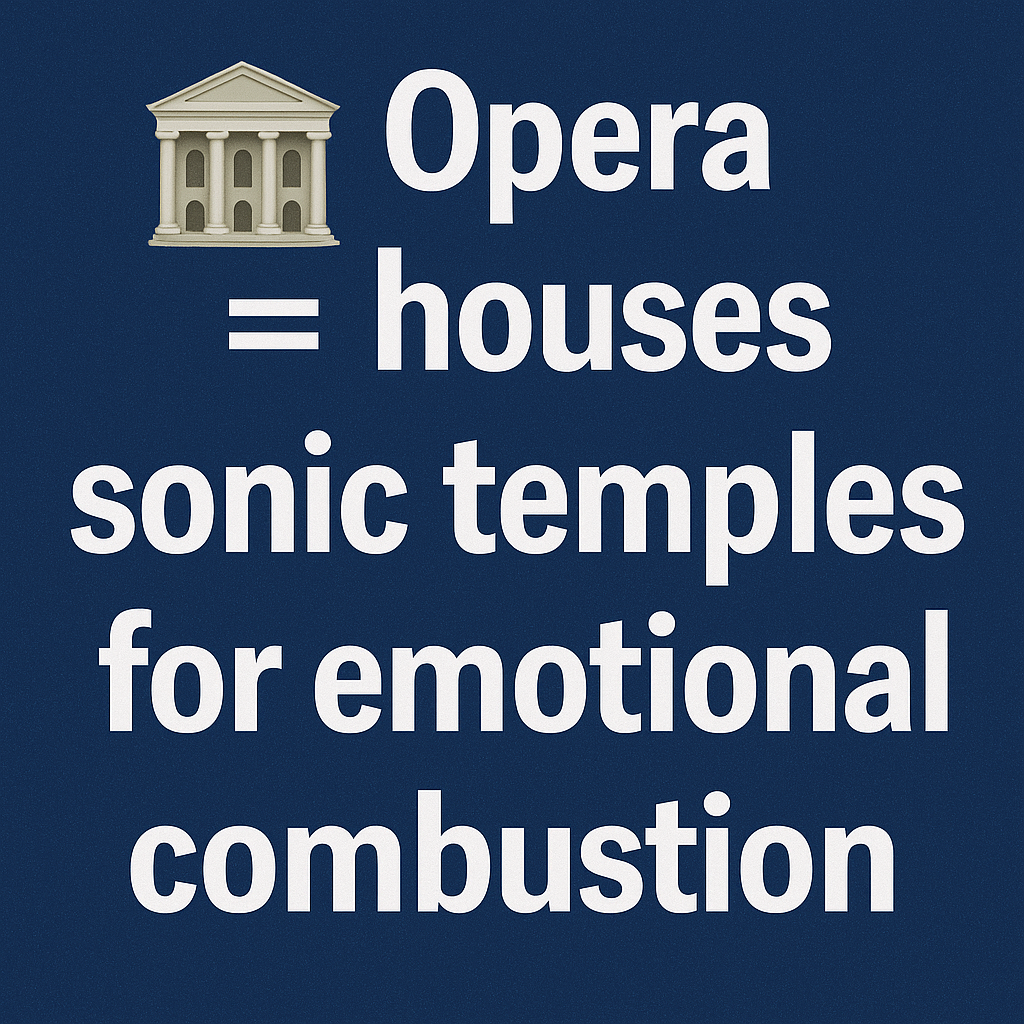
The Cathedral of Sonic Despair
Let us begin with the Oslo Opera House — a shimmering, glacier-shaped structure built of Carrara marble, concrete, and the accumulated guilt of an oil-rich democracy. Opened in 2008, it was conceived as a gift to the people. A shrine, accessible to all. Except for most performances, which remain quite expensive.
The National Opera & Ballet, housed within, receives more public money than any other single cultural institution in Norway — around 700 million NOK annually.
Its mandate:
- Preserve the operatic canon (especially the tragic parts)
- Introduce modern works that challenge middle-class expectations
- Employ dozens of highly trained humans in dance-based storytelling
- Offer at least one production per season where someone dies very slowly while singing
“They have constructed a marble frequency chamber where amplified sorrow is ritualized. Attendance is both optional and mandatory, depending on social class.”
To the alien anthropologist, this appears to be a grief amplifier — a sonic cathedral for processing communal feelings of love, betrayal, national pride, and existential tension. Every seat is subsidized. Every spotlight calibrated. It is, in effect, a national furnace for feelings.
But even within the priesthood, there is unrest. Internal reports note financial pressure, aging audiences, and the lingering stench of elitism. In 2023, the Opera itself warned of cuts and restructuring despite its vast subsidy. The ritual must continue — but the incense is getting expensive.
Application forms from Kulturrådet (2023)
– Allegedly included 11 tabs, 9 guidance documents, and emotional damage
The Temple of Tangible Memory
Located nearby is the National Museum of Art, Architecture and Design — a megastructure of glass and grey ambition, officially opened in 2022. It cost the state nearly 2.8 billion NOK, which was approximately 1 billion more than originally planned, not including aesthetic regrets.
Its contents:
- The nation’s finest visual art collection
- Paintings by Edvard Munch (not The Scream; that’s elsewhere)
- Exhibits of furniture, textiles, conceptual objects, and architectural blueprints
- Rooms designed to evoke memory, but with a controlled lighting budget
The building has been praised and mocked in equal measure. Some call it a bunker. Others, a storage facility for unprocessed emotion. The government refers to it as “Norway’s common cultural memory made physical.”
“They preserve artifacts of their myth-making inside climate-controlled rectangles. These are visited by citizens for reassurance that they exist.”
One scandal erupted when it was discovered the floor in a main gallery was too weak to support the planned exhibits. For weeks, this symbol of national memory sat partially empty — a metaphor which, ironically, pleased several local poets.
🛑 INCIDENT REPORT
During observation of a community dance theatre project titled “Glacial Memory: A Movement Poem About Loss”, the following was recorded:
Project required to quantify emotional resonance using anonymous online surveys. One participant wrote: “I cried. 4/6.”
Alien committee concluded this is an advanced form of sacred metricization, wherein affect becomes analytics and experience must be statistically legible to be real.
The Stages of Canonical Struggle
The state supports multiple flagship theatres, including:
- Nationaltheatret (Oslo)
- Trøndelag Teater (Trondheim)
- Den Nationale Scene (Bergen)
- Hålogaland Teater (Tromsø)
Each receives tens of millions annually to maintain a repertory of:
- Norwegian classics
- Translated modern tragedies
- Experimental monologues involving nudity and LED screens
- Plays in dialect, often about fathers, fishing, or furniture
The theatres serve dual functions:
- Preserve national literary heritage (Ibsen, mostly)
- Deliver funded discomfort to audiences in designer seats
“The humans have codified social dysfunction into dramas, which they re-enact repeatedly to purge collective guilt.”
These stages are where symbolic tension meets state investment. They are deeply respected, often criticized, and perpetually under renovation.
Meanwhile, smaller theatres — especially in rural areas — operate with limited resources and periodic envy.
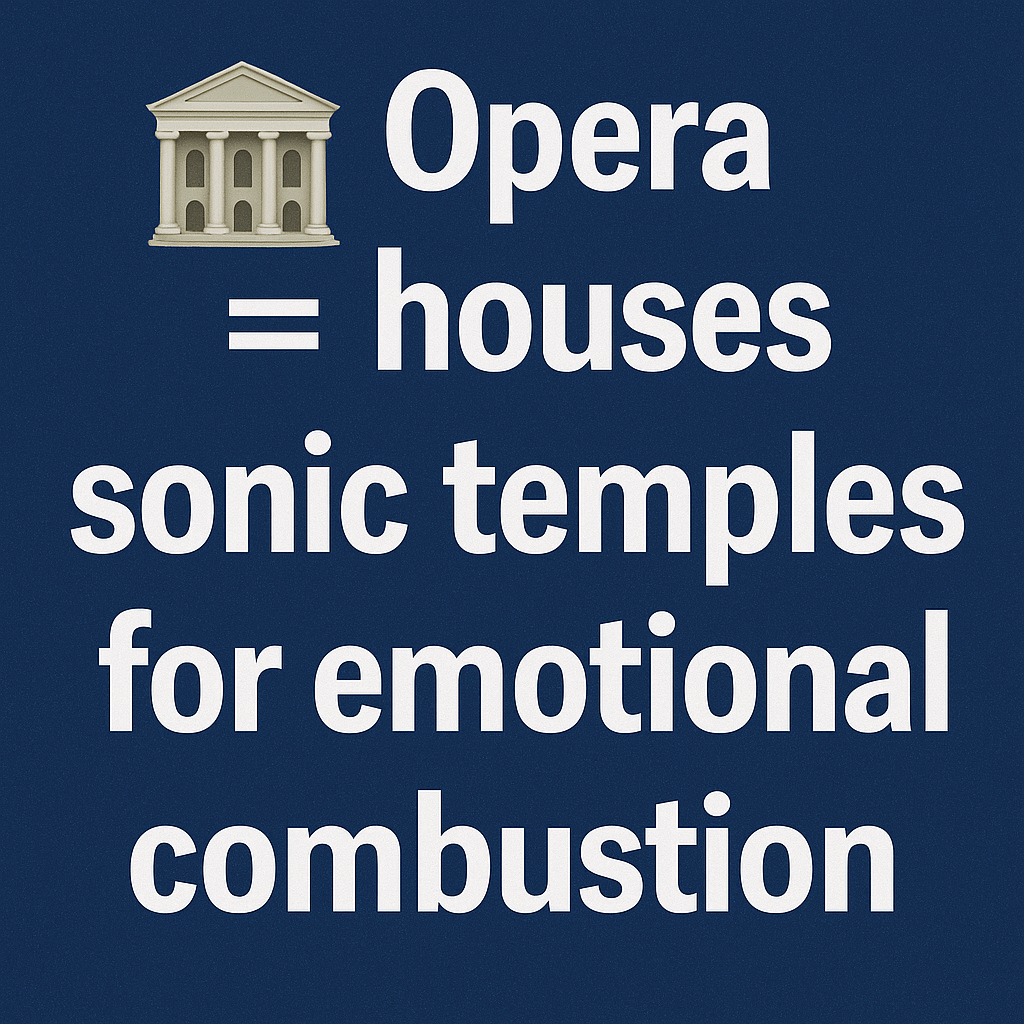
The Vaults of the Rememberers
Beyond the capital’s grand institutions lies a network of funded memory zones:
- Regional museums (e.g. Nordnorsk Kunstmuseum, Sogn og Fjordane Kunstmuseum)
- Historical collections (war artifacts, Viking ships, the evolution of the butter knife)
- Living museums (Sámi heritage, fishing life, 1950s tractors)
- The National Library, which digitizes all published Norwegian content and stores it in a concrete mountain in Mo i Rana
These institutions are considered essential for cultural continuity. In total, they receive billions in combined funding, not including infrastructure upgrades. A museum may serve 3,000 visitors a year, yet employ a dozen professionals and receive a robust subsidy to ensure that no butter knife goes uncurated.
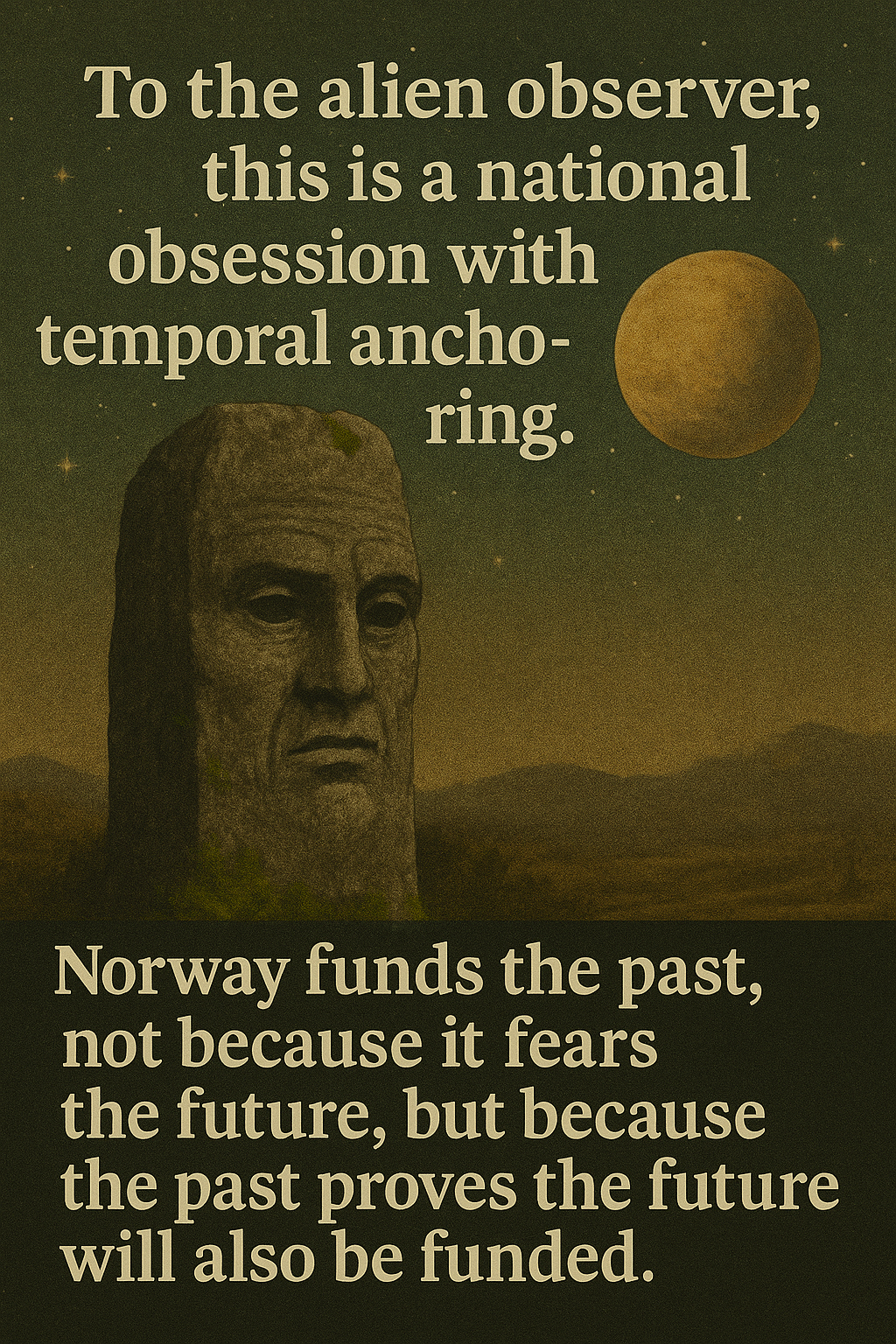
Ritual vs The Freelance Tension
Not all creators worship within the funded temples. Across the country roam thousands of freelance artists — dancers, writers, performance engineers, community-based sound theorists — who do not inherit marble but must apply for temporary sanctuary via project grants and stipends.
They are often underpaid. Frequently overeducated. Periodically uplifted by the State Artist Grant (Statens Kunstnerstipend) — a system that offers select individuals a basic income to create meaning as they see fit.
Recent budgets have increased funding for these wandering interpreters, acknowledging that without them, the temples risk fossilization. Still, the tension persists: 93% of all state culture funding goes to institutions, leaving only a sliver for freelance innovation.
“The Temple Priests receive daily bread. The Wanderers receive seasonal breadcrumbs. Yet both are vital to the ritual system.”
Backlash and Budget Blowouts
The temples are not immune to critique. Notable clashes include:
- Munch Museum Budget Scandal: projected 1.6 bn → final 2.8 bn NOK
- Opera House Criticism: “Too Oslo-centric” vs “Symbol of modern Norway”
- Audience Relevance Debates: declining ticket sales among under-35s
- Scandals over Artistic Content: nudity, political satire, stage defecation
Public discourse periodically erupts. Politicians demand accountability. Newspaper columnists fume. Budget reviews are launched. And yet — the money still flows.
Norway does not defund temples.
It renovates them.
The investment in sacred cultural buildings serves many purposes:
- International Prestige
- Domestic Unity
- Physical Anchors for Abstract Values
- Acoustic Optimization of Orchestral Emotion
They are loved, loathed, photographed, and defended.
And they work.
Because when citizens gather in marble structures to listen to fictional suffering amplified by state-subsidized microphones, something very real occurs: a society remembers that it is more than its paperwork.
THE APPLICATION RITE📄
How to Apply for Permission to Feel. Also known as “turning your soul into a spreadsheet, attaching three PDFs, and praying.”
🛰️ Transmission Supplement 4E: Ritualized Request Protocols in the NORWEGIAN CULTURAL SECTOR
In most sentient civilizations, art arises organically from the tension between survival and imagination. In Norway, it begins with an application form.
To create state-recognized culture in this subzone, one must first pass through The Application Rite — a carefully regulated, multi-layered initiation process administered by a neutral bureau known locally as Kulturdirektoratet (Arts Council Norway). This organization is the sacred middle-management of national emotion. It holds the keys to the treasury, and more importantly, to validation.
Over 20,000 humans perform this rite annually.
Roughly half are denied.
The Gatekeepers: Kulturrådet and the Arms-Length Clergy
Kulturrådet is an “arm’s-length” institution. This means that while it is funded by the government, it operates independently from political influence. Its mandate is to evaluate artistic proposals without direct interference from ministers, parties, or voters. Instead, the decisions are made by a rotating council of expert humans, selected for their artistic knowledge and bureaucratic resilience.
These gatekeepers — known on Earth as peer review committees — function like semi-autonomous priesthoods, fluent in both symbolic theory and budget formatting. Their role is to:
- Read hundreds of applications
- Discern artistic merit using calibrated intuition
- Determine which humans may proceed with their proposed symbolic activity
- Publish a list of those found worthy
“They have created a priestly caste to evaluate ritual proposals in the absence of a central god.”
Anatomy of a Grant Application
To gain access to the Offering, one must prepare and submit the following components:
🧾 1. Project Description
A 3–6 page explanation of the planned artistic activity. Must include:
- What it is
- Why it matters
- How it differs from similar activities occurring in Malmö
- Whether it will “reach underrepresented audiences”
This is the applicant’s philosophical statement, usually formatted in Arial 11pt.
📊 2. Budget
Must include:
- Artist fees
- Production costs
- Travel (with explanation for any non-sustainable modes of transport)
- Line item: “In-kind contributions from collaborative partners”
Numbers must be exact, even if the artistic vision remains cosmic.
🤝 3. Letters of Intent
From venues, co-producers, or partners who promise to support the thing, even if they don’t fully understand it.
🔄 4. Timeline
Must demonstrate feasibility of performing metaphor between Q2 and Q4.
🧩 5. Inclusion Strategy (if applicable)
May involve target demographics, decolonial perspectives, or specific outreach plans to engage teenagers who hate everything.
🧠 6. CV and Artistic Statement
Two documents designed to prove that the applicant has:
- Existed
- Done things
- Suffered in ways that are socially recognizable as art
Field Unit 7B attempted to submit an “Artistic Evaluation Report” to Kulturrådet using galactic encoding syntax. Submission rejected. Reason given:
“Formkrav ikke oppfylt” (Form requirements not fulfilled).
Unit 7B wept. Then learned to use Adobe Acrobat.
Categories of Sacred Labor
Grants are available for all major forms of human symbolic behavior. These include:
- Music (production, touring, composition, festival organization)
- Literature (book writing, translation, dissemination)
- Performing Arts (theatre, dance, staged research of grief)
- Visual Arts (exhibitions, installations, large-scale feelings rendered in steel)
- Interdisciplinary Projects (anything involving food, digital interfaces, or time travel)
🚦 Each category has its own application deadlines, review panels, and existential vocabulary.
The Judgement Day
After submission, applications enter The Period of Waiting — a span of 6–12 weeks during which nothing happens externally, but internally:
- Hope metastasizes
- Self-worth unravels
- New projects are conceived just to forget the current one exists
Eventually, a decision arrives.
✅ Approved: You receive money, brief applause, and five months of financial relief.
🧨 Denied: You receive a sentence fragment and the word “unfortunately.” Your proposal will not be realized unless you translate it into a funding-compatible language.
“The cycle of application and rejection simulates the Earthling’s desire to be seen, even when unseen.”
Ritual of Stipends - The State Artist Grant
A separate, more permanent rite exists for those who seek not just project support, but existential endorsement: the Statens Kunstnerstipend (State Artist Grant).
This system provides 1–5 year stipends to individuals who have demonstrated sustained symbolic contribution. Recipients receive:
- A fixed monthly income (≈ NOK 300,000–350,000 per year)
- No requirement to produce measurable results
- The freedom to pursue metaphor professionally
- Occasional resentment from relatives with normal jobs
Applications are fiercely competitive. The rejection rate hovers above 85%. The recipients become semi-mystical figures: The Funded. They move through society with a quiet aura of legitimacy and mild tax complications.
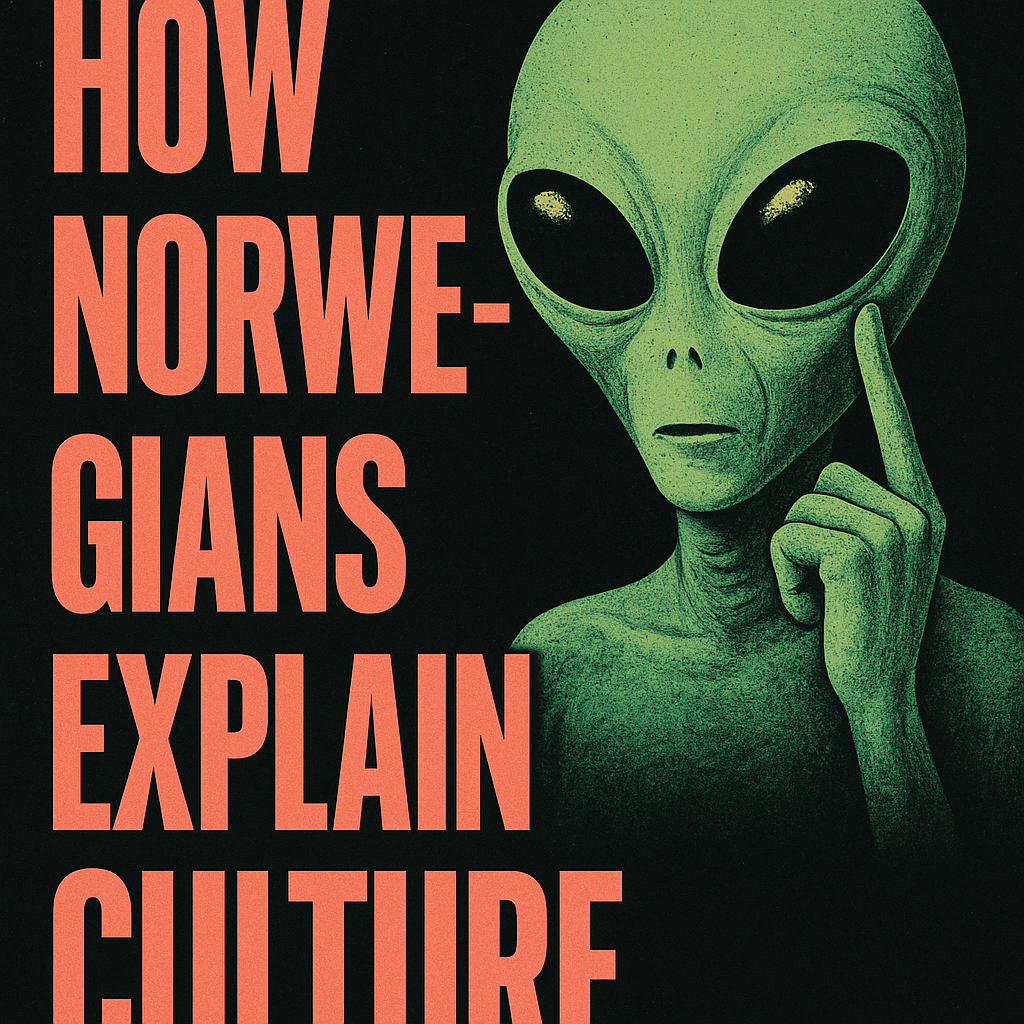
The system is often praised for its fairness and transparency. But also criticized for:
- Administrative opacity
- Artistic jargon inflation
- Uneven representation
- Funding safer projects over radical experiments
- Requiring 4 weeks of paperwork to apply for a 2-week performance in a former bomb shelter
This has led to a counter-genre known as meta-application art — in which the act of applying is itself the art. Examples include:
- An artist who submitted the same project 17 times, documenting his own rejection process as a performance
- A group that applied for a grant to build a bureaucratic sculpture made of grant rejections
- A piece titled Formskjema Ritual #5: Everything I Ever Had to Prove
“The application process has become its own rite of passage — both gate and stage.”
Memetic Map: The Application Lifecycle (Simplified)
[Inspiration] → [Research Deadline] → [Despair] → [Admin Portal Crash] → [Submission] → [Sleep] → [Anxiety] → [Refresh Email 48x] → [Rejection] → [Reframe Project as Performance] → [Repeat]
Who Gets Funded?
According to recent data from Kulturrådet:
- ~50% of music applications are funded (relatively high due to band logistics)
- ~35–40% for performing arts
- ~25–30% for visual art
- ~20% for interdisciplinary wildcards
- Artists from urban centers (Oslo, Bergen, Trondheim) are statistically overrepresented
- Projects using the word “resonance” have higher success rates, though causality is unclear
The Application Rite has faced critique from:
- Artists of color, citing barriers to access and cultural translation
- Neurodivergent applicants, for whom form fields are emotional warfare
- Rural artists, who feel geographically peripheral
- Everyone, during Mercury retrograde
In response, Kulturrådet has introduced:
- Simpler application formats for smaller grants
- Outreach programs in minority communities
- Pilot programs for “artist-admin collaboration” (a bureaucrat and an artist co-write your proposal — think spiritual bookkeeping)
Still, many artists report burnout from the process of legitimizing their practice. The art may be good. But is it KPI good?
The Application Rite is not merely an administrative procedure.
It is:
- A national sorting mechanism for invisible labor
- A simulation of recognition
- A publicly funded identity factory
- A spiritual audition where belief must be documented in triplicate
The system is imperfect, complex, noble, exhausting, and — crucially — survivable.
For those who pass through it, what emerges is not just a funded project.
It is a new self.
And in Norway, that self may be reimbursed for travel and materials.
A close study of intra-tribal tension, interpretive screaming, and the collapse of faith in subsidized transcendence.
⚠️ OBSERVED SYSTEMIC FRACTURES
Despite the elegance of NORWEGIA’s Emotional Infrastructure, multiple tensional fault lines compromise the structural cohesion of its symbolic economy. These ritual fractures may cause system drag, public outrage, or political opportunism.
🪓 1. THE GREAT DIVIDE: Institutions vs Freelancers
Institutions receive stable, multi-year offerings regardless of attendance fluctuations.
Freelancers navigate the Cultural Hunger Games — annual application cycles, peer review panels, and rejection by PDF.
Up until now, our report has treated the Norwegian cultural economy as a mostly stable ritual system. And it is — structurally. The bureaucracy functions. The offerings are made. The priests do not devour each other.
But no symbolic infrastructure survives unchallenged.
Beneath the marble temples and PDF-based spirituality lies a simmering tension — a disagreement, not just about how much culture should be funded, but what counts as culture in the first place. Is a man screaming naked in a warehouse art? What about two poets writing a joint memoir on failed intimacy using only PowerPoint slides? Or a play performed entirely in invented dialect while the audience lies in bean bags?
To the cultural class, these are experiments — vital, urgent, deserving of support.
To many outside the class, they are symptoms of elite decadence. Or worse: waste.
Thus, the rise of an unlikely challenger: the Sløseriombudsmannen.
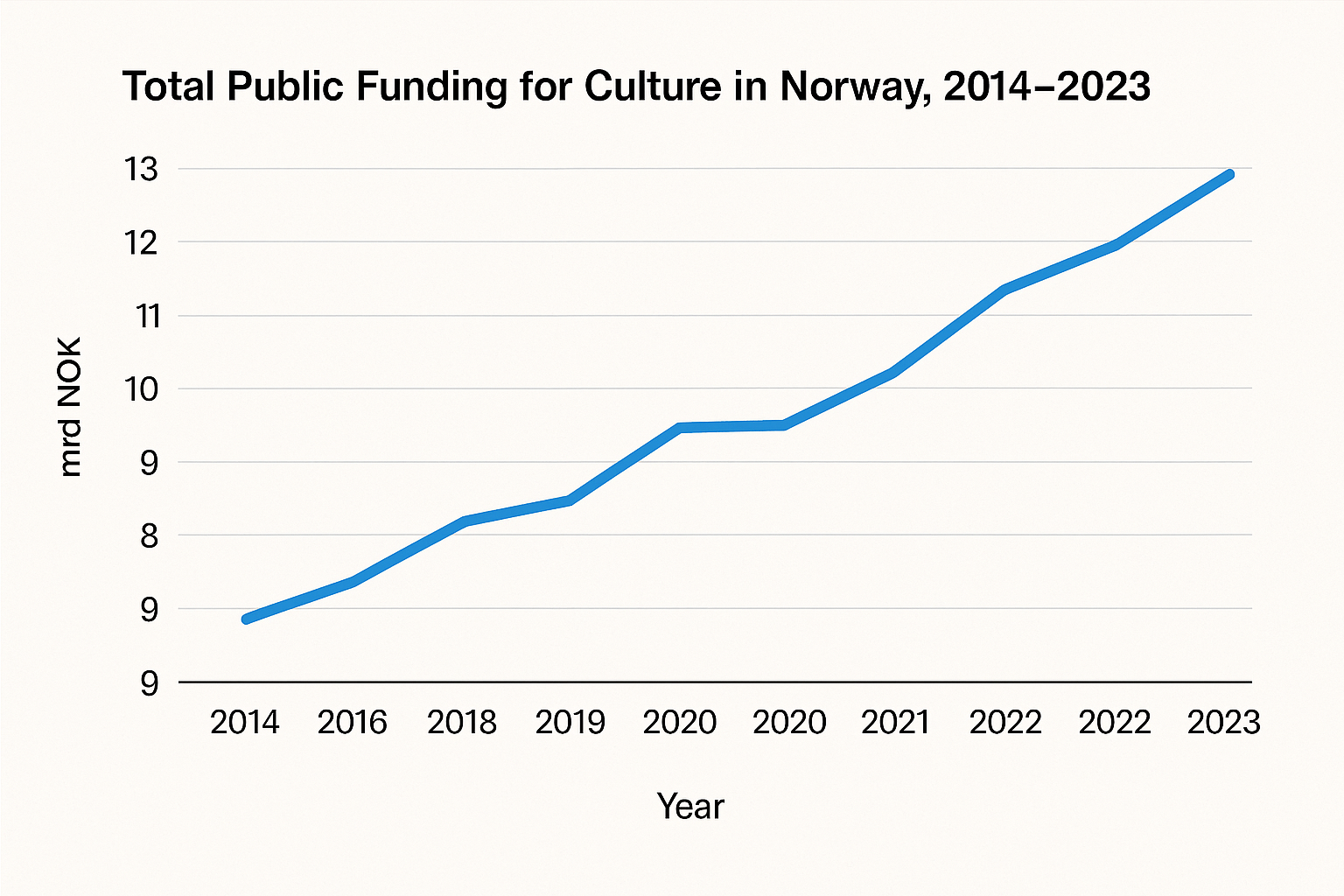
🎭 PERFORMANCE PRESSURE IN SUBJECTIVE FIELDS
Artists are increasingly required to predict, measure, and report intangible emotional outcomes.
- Example grant requirement:
“Describe how this project will contribute to diversity, climate responsibility, and measurable social impact.”
🧮 METRIC CONVERSION OVERLOAD
When culture must prove its worth numerically, symbolic distortion occurs.
Projects begin to simulate impact, not generate it.
- Example metric: Audience per kroner spent per minute of production
- Unintended outcome: “Compressed emotional duration for cost-efficiency”
“The Ritual is now optimized for spreadsheet compliance.”
The Wastage-Watcher Appears
Sløseriombudsmannen (literally, “The Waste Ombudsman”) was not born in a theatre. He did not emerge from the cultural priesthood. He arrived from the shadow realm of Facebook — that strange social media lagoon where grievance, populism, and memes converge.
He began as an anonymous critic posting links to public spending he found absurd:
- 800,000 NOK to a performance artist who rolled in paint
- 350,000 NOK to an installation involving glitter, nudity, and humming
- 1.2 million NOK for a traveling experimental circus with no clear theme
Each post included screenshots from official grant databases, often paired with derisive commentary and a healthy dose of middle-class exasperation. The posts went viral.
By 2020, Sløseriombudsmannen had become a cultural force of his own — albeit one bent on deconstruction.
Soon, he had:
- 60,000+ followers
- Interviews in national newspapers
- Support from right-wing politicians
- Death threats from enraged choreographers
“Factions within the emotional priesthood have declared interpretative jihad.”
His critiques struck a nerve. For many Norwegians — particularly those outside Oslo or outside the arts ecosystem — Sløseriombudsmannen’s feed was the first time they saw what their tax kroner were funding in the name of “culture.”
And it looked weird.
Too weird.
Not just misunderstood. But actively offensive to common sense.
And so a narrative emerged:
- The artists are laughing at us.
- They get paid to pretend.
- They take our money and then call us stupid.
- This is elitism in powdered form.
Cultural leaders were unamused. They called it harassment. They argued that:
- The posts lacked context
- Complex works were reduced to punchlines
- Artistic freedom was under threat
- Nobody critiques defense spending with the same intensity
Meanwhile, Arts Council Norway remained publicly silent, continuing to process grants as usual. Ministers of culture called for “robust debate,” but did little else.
The alien observer might note this as ritual resilience — the priesthood refusing to flinch even as the public throws tomatoes.
Still, the impact was undeniable.
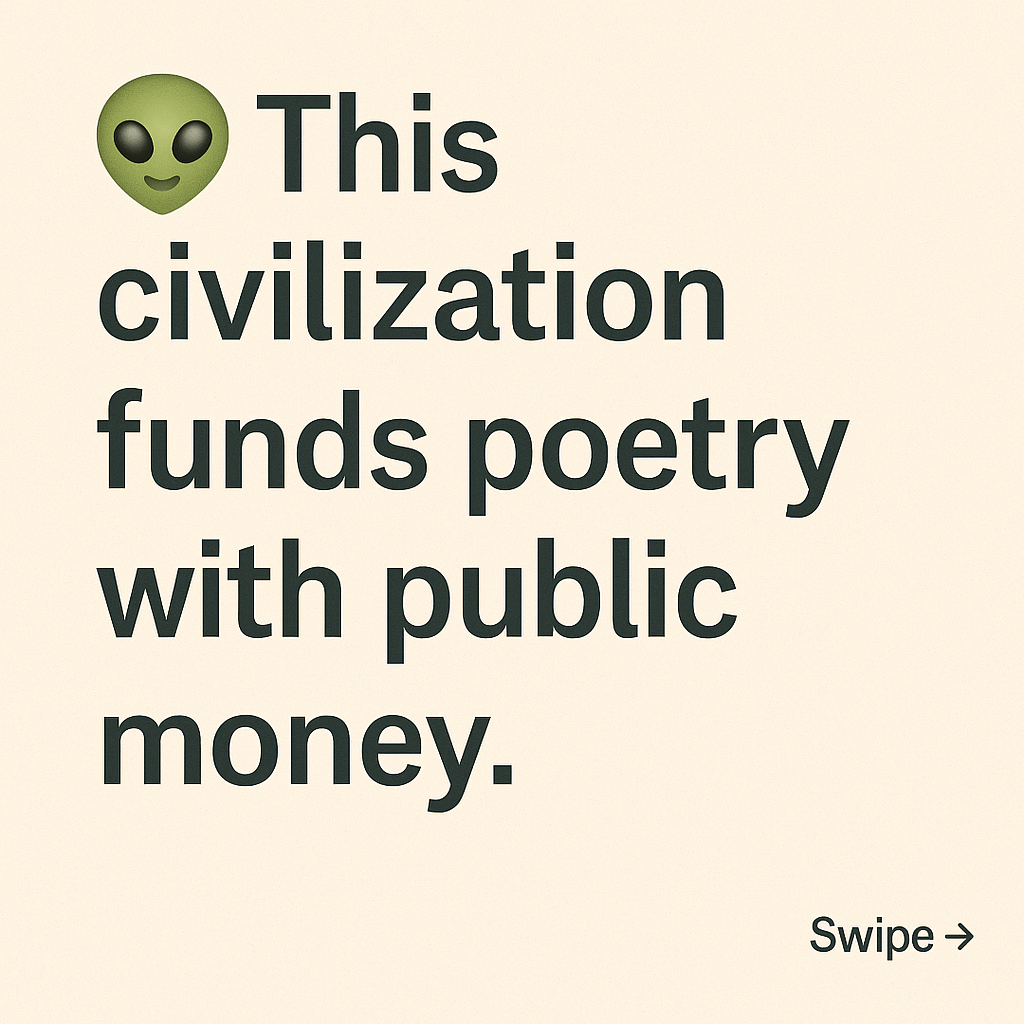
By 2021, Sløseriombudsmannen’s influence had reached Parliament. Members of the Progress Party (FrP) — Norway’s populist-right faction — began citing his posts during budget debates. One MP called for defunding projects that “actively insult the taxpayer.”
The cultural community panicked.
This wasn’t just a meme anymore.
It was a possible shift in doctrine — from funding meaning expansively, to demanding justification through populist appeal.
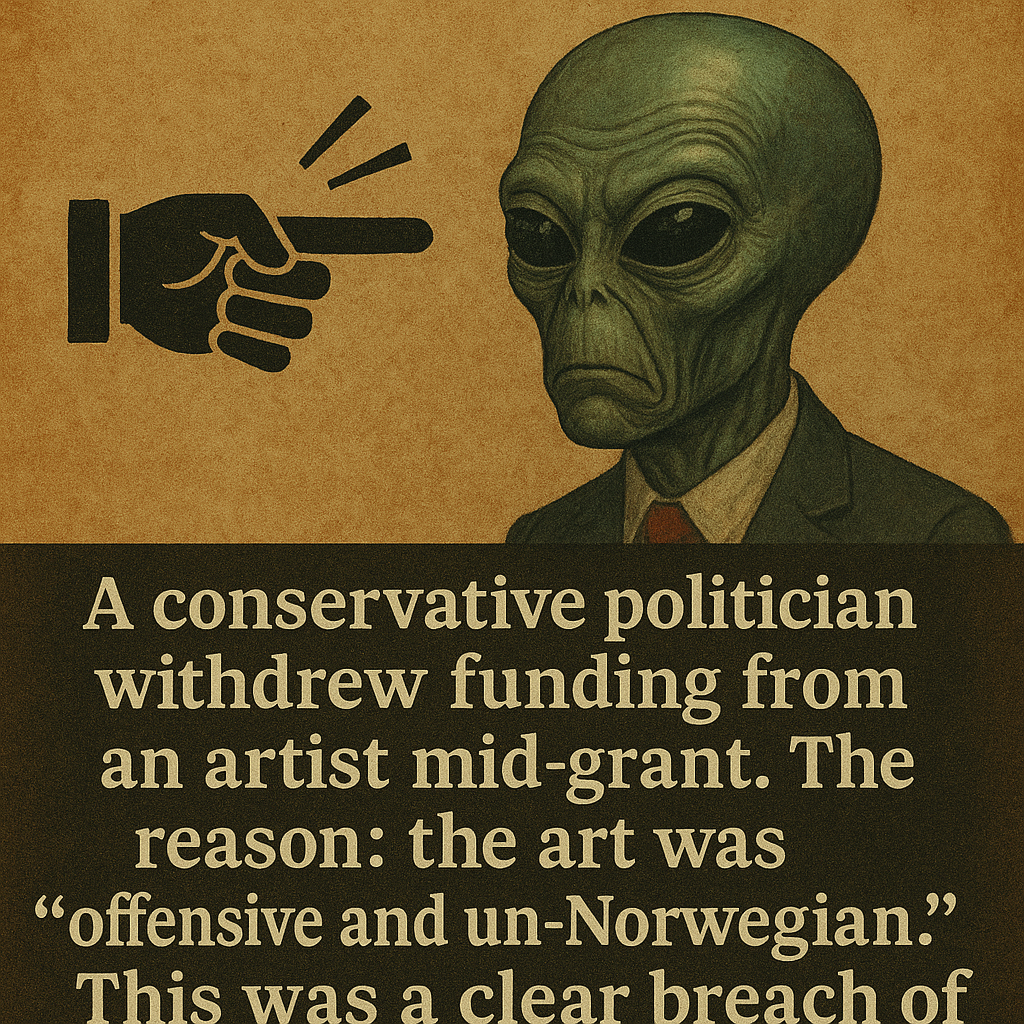
In a surprising twist, a group of artists responded not with lawsuits, but with theatre.
They staged a play called Sløserikommisjonen — a courtroom satire in which the Wastage Ombudsman was put on symbolic trial. The piece toured nationally. It was funded by public grants. It included testimonies, video montages, and live debate.
Audience reactions were divided:
- Some left more sympathetic to the arts
- Others left convinced they had just funded their own ridicule
One headline read:
“Norwegian artists create grant-funded defense of grant funding. Audience confused but emotionally moved.”
“The priesthood defended itself by dramatizing its enemies — a self-consuming rite designed to restore equilibrium through irony.”
Beyond Sløseri, other controversies have punctured the public bubble of trust:
- The Munch Museum in Oslo more than doubled its initial budget — from 1.6 to 2.8 billion NOK. Critics asked: Is memory worth marble at this scale?
- The National Museum’s grand opening was marred by flooring failures, leading to public jokes about “conceptual stability”
- One arts project funded with over 1 million NOK was revealed to consist of a man filming his own boredom in real time
Each headline chipped away at the narrative of responsible stewardship.
In response, cultural agencies published more reports, more metrics, more logic models. But public perception, once cracked, is difficult to reseal.
The core of the conflict may not be about art at all. It may be about class.
- The cultural elite speak in concepts
- The general public speaks in discomfort
- Artists defend complexity
- Voters demand legibility
To an alien observer, this appears as a rift between those who live inside metaphor and those who only fund it. Neither side is wrong. Both feel misunderstood.
One artist writes:
“We create symbolic space for things language cannot hold.”
One citizen replies:
“Then explain what I just paid for.”
Despite the fury, Norway’s cultural funding remains intact. No major defunding wave followed the Sløseri years. If anything, recent budgets have increased support for freelancers, minority voices, and digital art.
But the system is now self-aware.
Grant applications are worded more carefully. Institutions pre-emptively defend projects. Artists are trained in “audience communication.” Even PR firms have entered the arts sector.
The Offering continues. But the rituals are watched.
EMOTIONAL BURNOUT & RITUAL FATIGUE
- Artists report chronic application trauma
- Administrators suffer grant review hallucinations
- Public confusion: “Didn’t we already fund meaning last year?”
One artist’s quote:
“I’ve spent more time explaining why I should make art than actually making it.”
From our vantage point, Norway has achieved something remarkable:
- A symbolic economy large enough to include its own critics
- A ritual system that absorbs dissent by dramatizing it
- A funding machine that occasionally mocks itself, and survives
The Sløseri episode was not a collapse. It was a self-corrective shudder — the system’s emotional firewall being stress-tested by satire.
In most galactic regions, this ends in rupture.
In Norway, it ends with another play.
Funded.
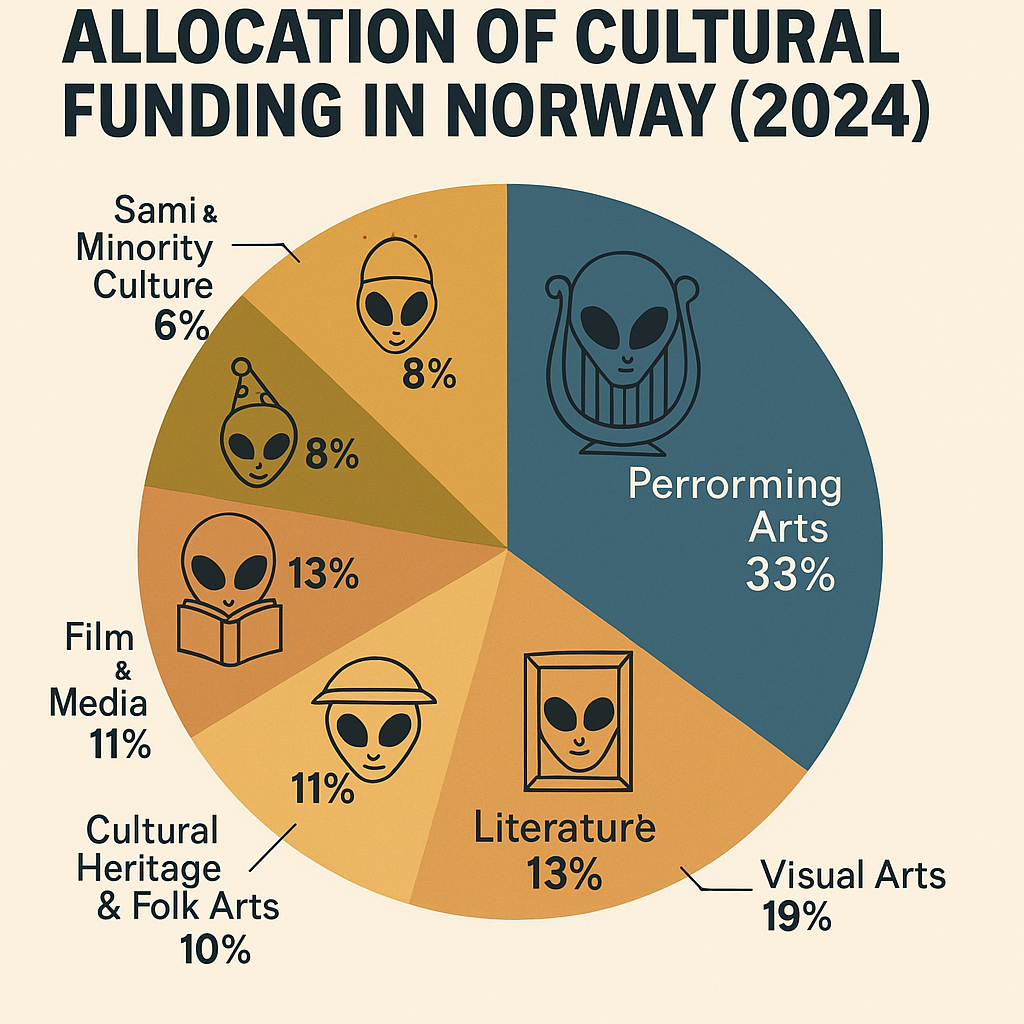
INCLUSION, OUTREACH & INTER-TRIBAL DIPLOMACY🌍
How to Avoid Cultural Civil War Using Poetry and Joik. A field report on ritual equity mechanisms, ceremonial decentralization, and harmony through well-funded discomfort.
🔚 CLOSING STATEMENT FROM FIELD UNIT 5K
“The NORWEGIAN SYMBOLIC ECOSYSTEM is resilient — but noisy. Rituals persist. Faith remains.
Still, we advise caution: symbolic cohesion cannot survive endless quantification, aesthetic suspicion, or annual reboot cycles. Meaning must be tended, not just counted.”
🛰️ Transmission Supplement 6D: Unity Maintenance Through Symbolic Redistribution (Sector: NORWEGIA)
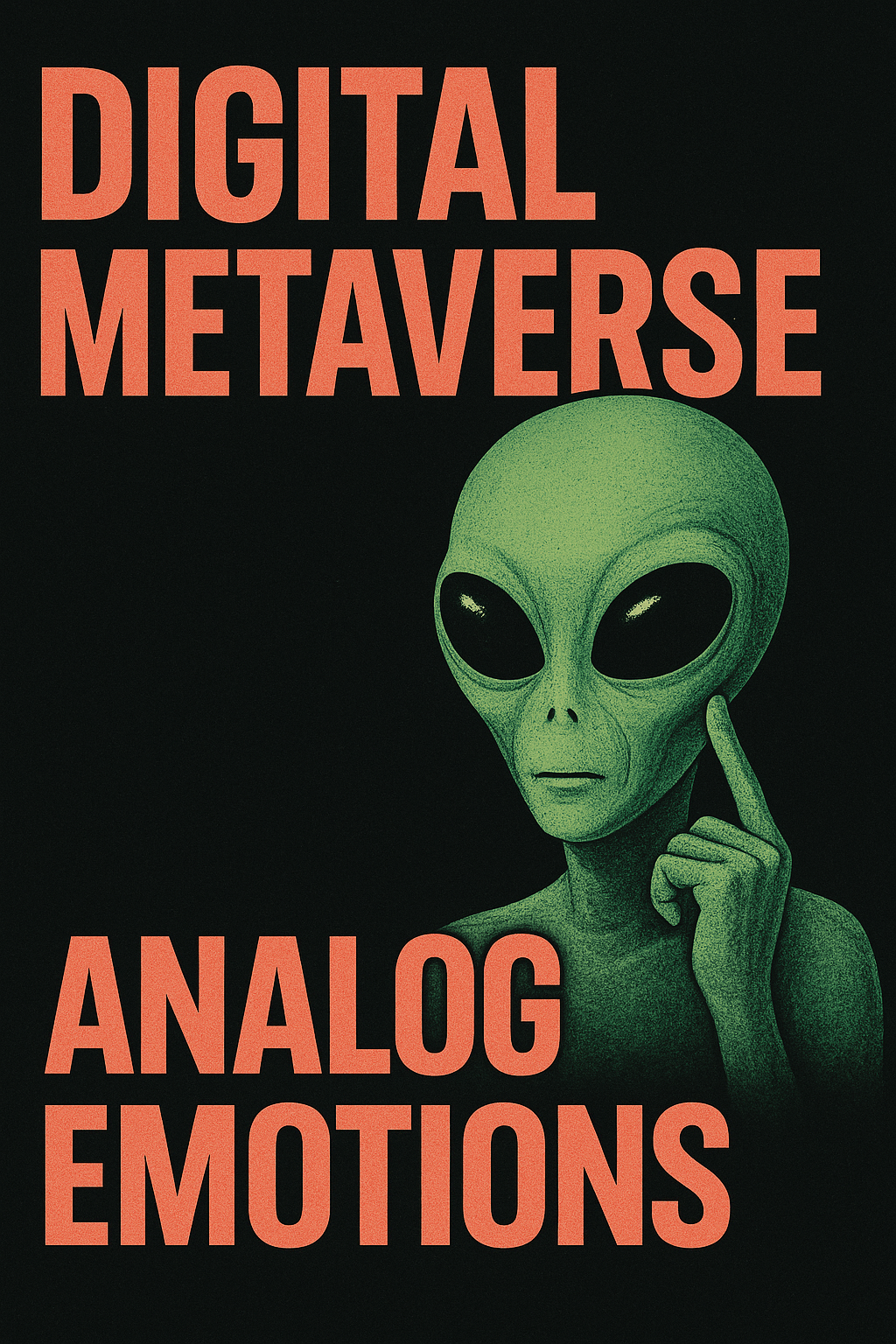
Most planetary civilizations have discovered that cultural identity is not monolithic. Norway, however, has gone a step further: it funds the fragmentation.
Rather than enforcing a central narrative, Norway’s Ministry of Culture and associated agencies actively invest in many narratives, counter-narratives, lost narratives, and emerging metaphors from humans who, historically, were told to sit down and enjoy the opera.
This effort is not just social policy.
It is existential maintenance.
Because if one group’s pain is ignored for too long, eventually they stop attending the rituals altogether — or worse, start writing their own, without subsidy.
In this section, we examine Norway’s strategies for symbolic inclusion — not as charity, but as structural diplomacy between sub-tribes.
The Sacred Category: “Mangfold” (Diversity)
Norwegian cultural policy now includes an entire operational logic labeled mangfold — diversity. But this term is not limited to ethnicity. It includes:
- Geographic inclusion (rural vs urban)
- Socioeconomic background
- Disability
- Sexuality
- Language
- Age (especially youth and elders)
- And, implicitly, those who hate opera but still pay taxes
Funding agencies increasingly require applicants to demonstrate:
- Diverse collaboration teams
- Audiences beyond the art school corridor
- Efforts to reach people who don’t subscribe to cultural newsletters
A grant application for a puppet theatre in Bergen must now explain who hasn’t been to puppet theatre yet, and why this show will change that.
This shift is not rhetorical. It’s enforced through:
- Dedicated grant lines for diversity-focused projects
- Scoring rubrics that include “inclusion impact”
- Staff training in cultural sensitivity
- And the occasional conference with PowerPoint titles like “Decolonizing the Application Form”
“The priesthood is attempting to open its temples to all sub-tribes — not by invitation, but by funded reinterpretation of the rituals themselves.”
The Indigenous Constellation of The Sámi Cultural Framework
Of all Norway’s symbolic sub-tribes, the Sámi people have the most structured form of cultural autonomy. Spread across the north of Norway, Sweden, Finland, and Russia, the Sámi are recognized as indigenous, with their own parliament (Sametinget), languages, traditions, and — crucially — budgetary control over their own cultural symbols.
Each year, the Norwegian state transfers funding directly to the Sámi Parliament, which in turn distributes it to:
- Theatres (e.g. Beaivváš Sámi Našunálateáhter)
- Museums (e.g. RiddoDuottarMuseat)
- Music programs (particularly joik, the personal vocal tradition)
- Language revitalization projects
- Sámi artists and collectives
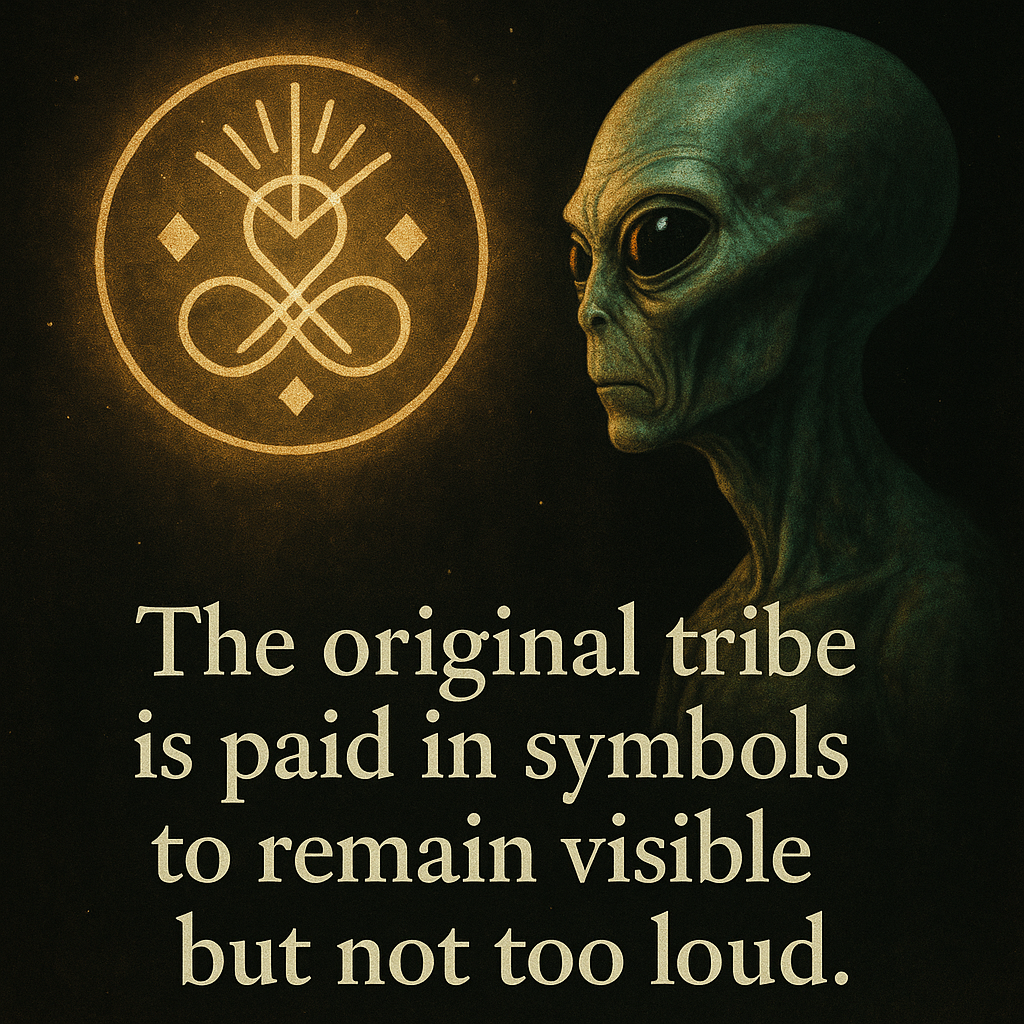
This is not decorative funding. It is foundational sovereignty through symbolic control.
One example: the Bååstede Project, a long-term initiative to return Sámi cultural objects from national museums to Sámi-controlled institutions. The objects were not just placed in boxes. They were reclassified as living heritage — meaning they belong to communities, not collections.
“The sub-tribe once colonized has been granted custodianship over its own narrative architecture. The central tribe accepts this not with joy, but with budget transfers.”
A common critique in Norway is that Oslo receives too much culture — too many premieres, galleries, grants, critics, rituals, and eligible boyfriends.
“Give the poets just enough gold and visibility, and no one will riot.”
To address this, the state has created funding lines for regional arts centers, rural touring programs, and district-specific festivals. Examples include:
- Northern Norway’s “cultural lift” initiatives
- Film development grants in Sogn og Fjordane
- Funded stages in towns with fewer people than sheep
- Travel grants specifically for artists willing to perform in Finnmark during snowstorms
In 2024–25, the government announced:
- A 75 million NOK Regional Culture Fund
- Earmarked support for festivals outside major cities
- One-time boosts to municipal-level cultural programming
“Outer provinces are gifted symbolic parity, not infrastructural equivalence.”
This is part cultural justice, part survival strategy.
Because if culture stays in Oslo, the rest of the country may begin to treat it like a parasite.
“The central priesthood attempts symbolic redistribution to prevent rebellion by peripheral colonies. The offerings are adjusted for weather and distance from sushi.”
Norway has multiple official languages: Bokmål, Nynorsk, Sámi variants, and Kven, with others (like Romani) recognized in policy.
Cultural funding reflects this linguistic layering:
- Translation grants are available in all directions
- Literary publications in minority languages receive subsidies
- Public broadcasters are tasked with offering multilingual content
- Museums are increasingly required to translate wall texts into Sámi and English, a combo that still confuses tourists
There is also increasing focus on symbolic visibility:
- Who is represented in public art?
- Which artists are exhibited in national galleries?
- Whose stories are told on the main stage?
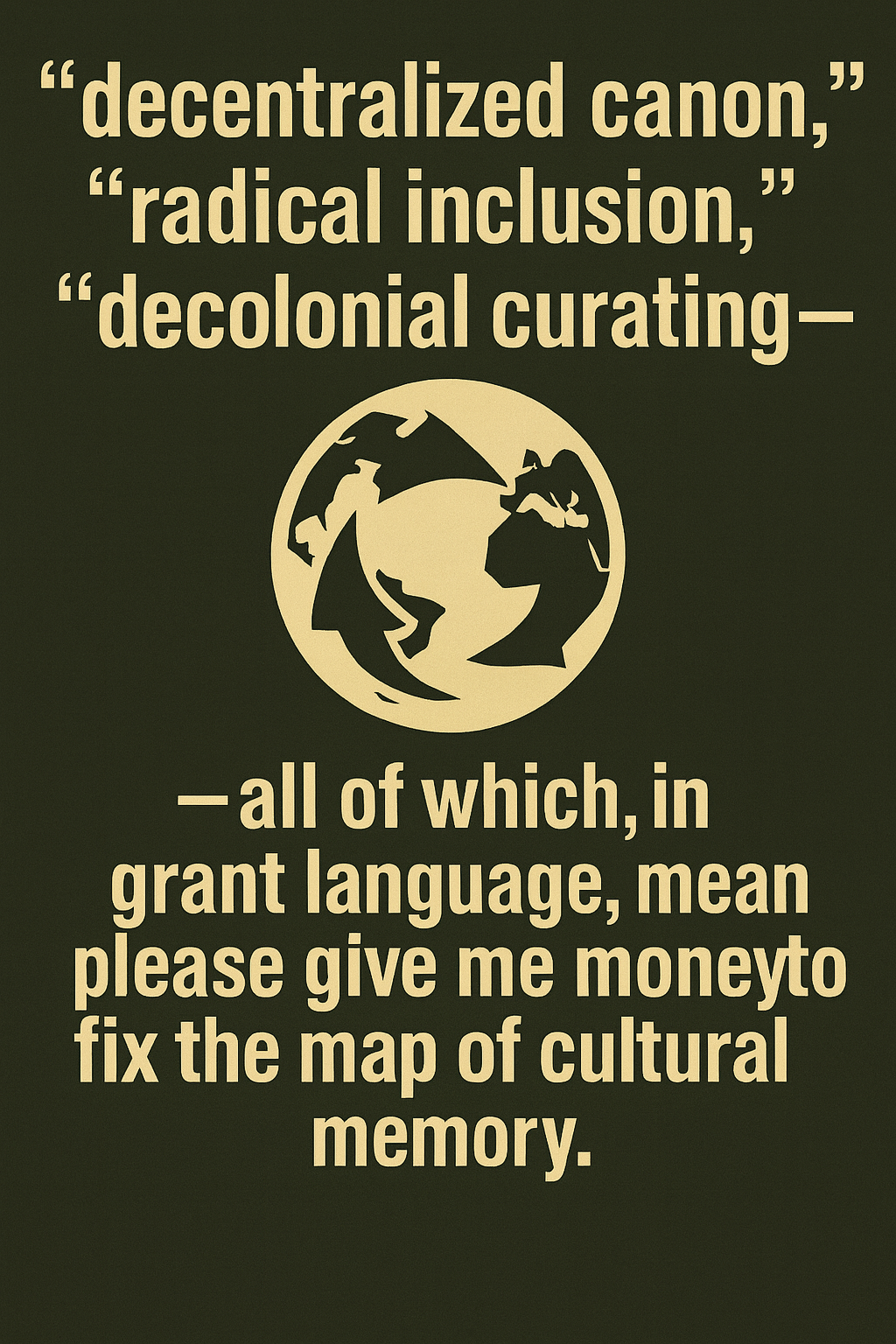
Ritual Examples of Inclusion in Practice
Let us review a few real phenomena funded under this broader policy of symbolic redistribution:
🎶 A Sámi electro-joik duo
Combining ancient vocal traditions with modular synthesizers. Funded by Arts Council Norway and featured in Berlin.
🎭 A Roma theater project
Developed with traveling artists and school workshops. Funded under minority outreach.
📖 A Nynorsk slam poetry anthology
Published with support from regional libraries. Performed live on a moss-covered barge.
🎨 An exhibition on “Queer Arctic Aesthetics”
Curated by trans artists from Tromsø. Reviewed by two critics and six trolls.
Each project comes with its own metrics, audiences, challenges — and its own moment of symbolic justice.
Critiques of the Diplomacy Model
Not everyone is satisfied.
- Some artists argue inclusion is tokenistic, underfunded, or bureaucratically extractive (i.e. you must describe your trauma before receiving a stipend).
- Others note that diversity officers rarely have actual funding power.
- Critics from marginalized communities report burnout from being the “representative applicant” over and over again.
There’s also a philosophical critique: if inclusion is measured by how many minority bodies are shown, without changing who controls the institution, is it truly inclusion?
These critiques are valid.
Norway’s cultural system absorbs them slowly. But unlike many systems, it writes them down, budgets for them, and sometimes — awkwardly — funds them to be performed.
Quote from a Kurdish-Norwegian playwright:
“I didn’t want to be a metaphor for anything. I just wanted to direct a play.”
Norwegian cultural policy does not erase tension. It funds the tension.
It does not demand one story. It diversifies the plot.
Its goal is not uniformity, but ritual coexistence — a society in which many tribes (ethnic, geographic, aesthetic) are granted space, money, and occasional microphones.
This is not utopia.
But it’s not chaos either.
It is, in planetary terms, a functional model of distributed meaning maintenance.
THE DATA TEMPLE
📊 Measuring the Unmeasurable in the Realm of Emotion
Inside the bureaucratic rituals that turn feeling into graphs.
After centuries of celestial observation, our analysts have concluded that no civilization has successfully translated emotion into stable numerical form.
Norway, however, remains convinced that it can.
Welcome to the Data Temple — the zone within Norwegian cultural policy where feelings are codified, spreadsheets are holy scripture, and artistic outcomes must be expressed in clear, quantifiable terms.
This is not mockery. This is compliance — a good-faith effort to justify public investment in symbolic infrastructure.
And yet: one cannot help but observe that a tragic monologue about grief rarely has a measurable bounce rate.
Cultural funding in Norway is justified by the sacred scrolls known as:
- Statsbudsjettet (State Budget)
- Kulturrådet årsrapporter (Arts Council annual reports)
- Evalueringer (Evaluations)
- Brukerundersøkelser (User surveys)
- Styringsparametre (Performance indicators)
Why does this exist?
Because even in an oil-rich society with a strong arts tradition, public money requires public accounting. The state must answer questions like:
- Who got funded?
- Why?
- What happened?
- Did it matter?
- Can we prove that it mattered?
Thus, the transformation of abstract experience into administrative metadata.
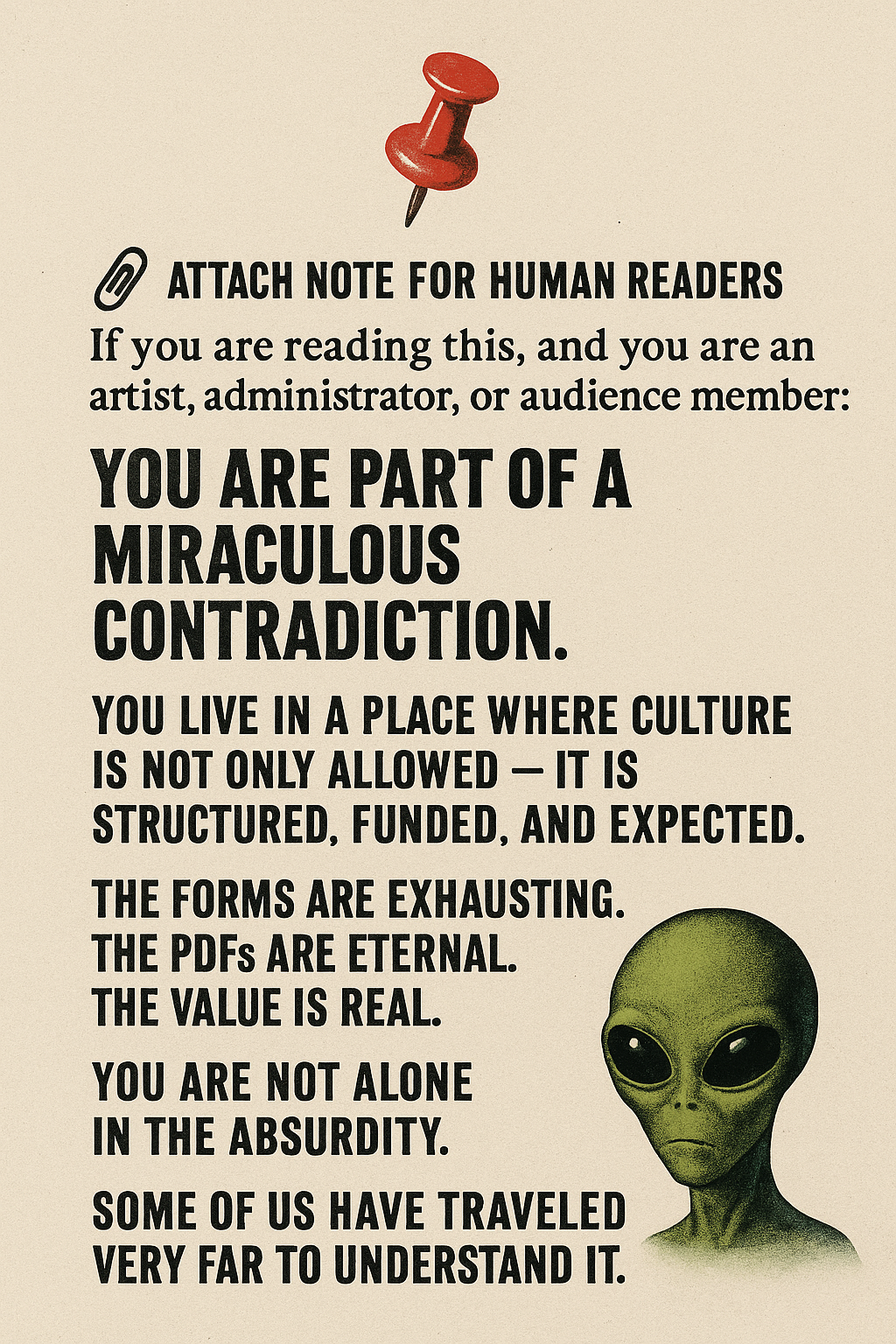
The Rituals of Reporting
All state-funded arts institutions, festivals, and grant recipients must submit performance data.
Typical metrics include:
- Audience numbers (paid and unpaid)
- Geographic reach
- Diversity of programming
- Representation stats (gender, minority voices, genre)
- Press mentions
- Social media engagement
- Budget compliance
- Achievement of previously stated objectives
Some also require:
- User satisfaction scores
- Qualitative impact statements
- Outreach efforts
- Environmental sustainability practices
These reports are compiled, charted, and delivered to:
- The Ministry of Culture
- The Arts Council
- The public via press releases
- The data archive gods who live in Excel and feast on context
When Art Becomes Excel-Compatible
To illustrate the paradox, consider:
📊 Example A: A performance art piece called “Silence After Collapse”
- Description: A durational event in which a dancer lies still in a fjord for 14 hours while a seagull watches.
- Reported impact:
- 87 spectators
- 2 local news articles
- 3 confirmed emotional reactions (as per on-site survey)
- 1 environmental partner (the fjord)
- 4 social media posts (not viral)
The piece received partial funding renewal.
📊 Example B: A rap workshop for youth in Ålesund
- Description: A series of lyric-writing sessions followed by performances
- Metrics:
- 38 participants
- 1 published album
- 2 dropouts who returned to school after the program
- 100% reported “feeling seen” on follow-up forms
This project received a glowing impact review.
The takeaway: emotion is permitted, but must leave traces that can be graphed.
The Kulturrådet introduced an “impact logic model” (virkningslogikk) to guide applicants and assess results. It includes:
- Input (money, staff, materials)
- Activities (events, programs, rehearsals)
- Output (performances, publications)
- Outcome (audience engagement, media reach)
- Impact (societal change, personal growth, symbolic resonance)
Each step is treated with the same seriousness as a national infrastructure project. Because it is one.
Norway sees culture not as entertainment, but as soft infrastructure for emotional cohesion.
“The humans invest in measured feeling as if it were a dam. We admire their optimism.”
The Critique of Measurability
Artists have voiced growing discomfort with the administrative weight of proving they exist. Common complaints:
- Time spent reporting exceeds time spent creating
- Metrics favor institutions over freelancers
- Art becomes shaped by what is easy to report
- Risk-taking declines, as failure is difficult to justify
Some arts workers now joke that they are “grant dramaturgs” — more fluent in applications than performance.
Others refer to this burden as “Excel Expressionism.”
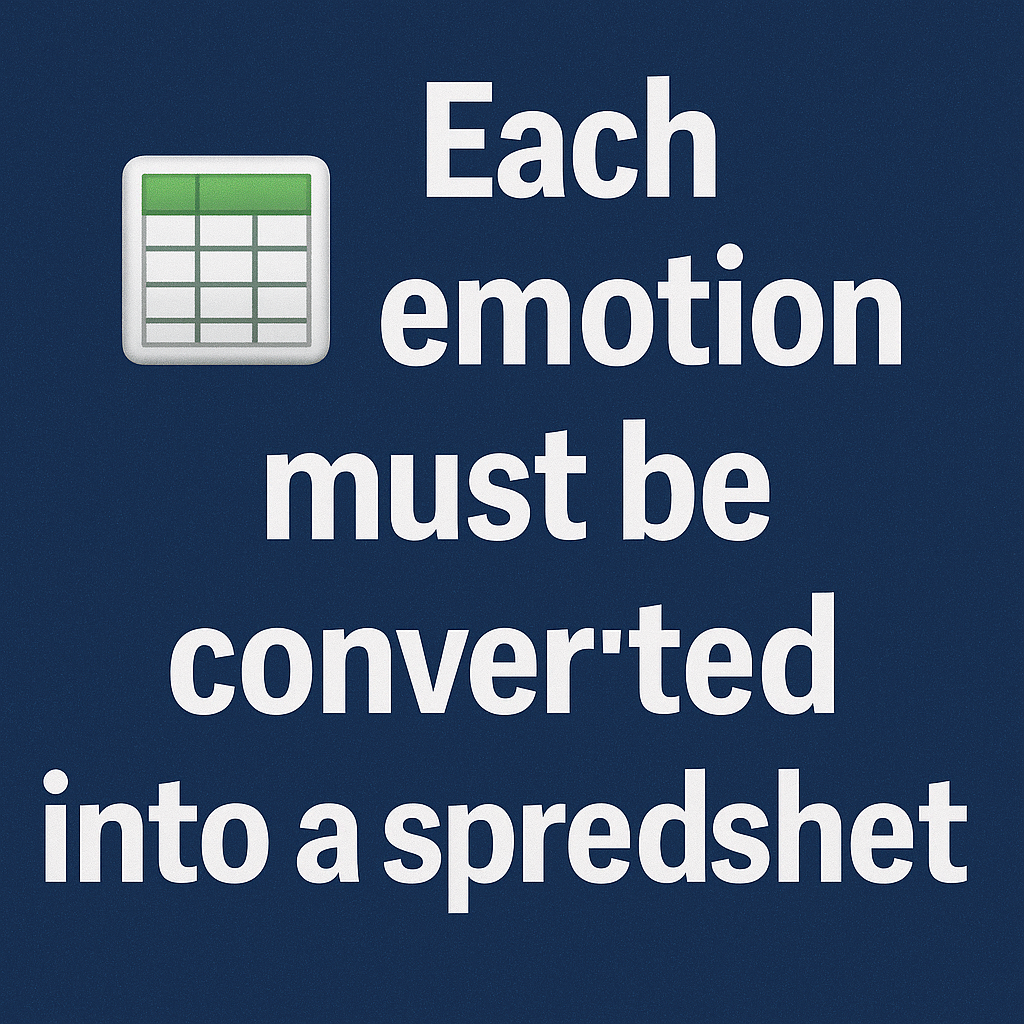
Here lies the central riddle:
Art resists certainty.
Evaluation demands certainty.
The artist’s truth may live in ambiguity. But the funding body’s spreadsheet requires legibility. So the creator must become both oracle and accountant.
Some embrace this duality. Others see it as a threat.
A performance artist recently submitted an impact report written entirely in iambic pentameter. It was rejected, though later praised in a policy blog.
Another responded to metrics with metrics:
“100% of our audience cried. 40% of them regretted it. We charted the regrets by decibel level.”
Attempts at Humane Metrics
In recent years, Norwegian funders have tried to soften the data temple by introducing:
- Narrative impact statements
- Self-defined success criteria
- “Learning outcomes” instead of rigid KPIs
- Feedback loops between artists and administrators
The hope is that artistic value can be honored even when it eludes math.
Still, the logic remains:
- If it was funded, it must be reported.
- If it was reported, it must be legible.
- If it wasn’t legible, was it really funded?
“This is a civilization caught between mystery and governance. They do not want to betray the sublime — only to explain it in annual increments.”
The Spreadsheet and the Song
The Norwegian model is not perfect.
But it is noble in its absurdity — attempting to quantify joy, grief, meaning, and revolution, so that they may be justified to future finance ministers.
Where other planets suppress culture, Norway counts it.
Where others dismiss art as frivolous, Norway codes it into the national record.
It is a slow, awkward ballet. But one worth documenting.
Even if no chart will ever capture the reason someone cried in the third row.
RECOMMENDATIONS TO GALACTIC COMMAND
🪐 Final Assessment of the Norwegian Cultural Organism
A closing transmission from Sector NORWEGIA, in which bureaucracy is poetry, and opera is subsidized.
🛰️ Final Log: NOR-CULTRA/0099-FULLYFUNDED-EXEGESIS
To: Galactic Command
From: Field Unit 7B (“The Interpretive Cluster”)
Subject: Cultural Intelligence Report on Humanoid Ritual Systems (NORWEGIAN ZONE)
This civilization considers
meaning a public utility.
Emotion is budgeted. Aesthetics are administered.
The symbolic function is funded,
often extravagantly.
And the paperwork is… dense.
After 36 rotational cycles embedded in the northern humanoid colony called Norway, we conclude that this civilization has developed a stable, state-funded symbolic ecosystem based on:
- A collective commitment to ritualized meaning-making
- A bureaucracy that treats poetry as infrastructure
- A fiscal theology in which public emotion is carefully measured, archived, and occasionally performed in bean bags
Our team encountered no uprisings, moderate controversy, and several standing ovations. This is considered successful.
Observed Functions
Rationale:
Culture is funded as a societal glue, a democratic right, and a public good — even if it cannot explain itself in economic terms.
🧾 Mechanism:
Funding is distributed through layers of councils, ministries, programs, and cryptic PDFs. It resembles a ceremonial labyrinth but functions with impressive regularity.
🫂 Inclusion:
The system performs symbolic outreach to all humanoid subgroups, including remote villages, indigenous tribes, queer fjord poets, and aging theatre makers with Bluetooth hearing aids.
📊 Justification:
Every funded project must demonstrate purpose, even if that purpose is the abstraction of despair. This is done using surveys, spreadsheets, and post-show emotional feedback forms.
🌀 Contradictions:
- Freedom vs. accountability
- Elitism vs. populism
- Beauty vs. budget
- Joik vs. Excel
CORE FINDINGS
Cultural production is a national responsibility, akin to snow removal or dental hygiene.
Symbols are redistributed to maintain peace across tribes, classes, geographies, and historical scars.
Measurement has overtaken meaning in many regions of the ecosystem, yet genuine wonder still breaks through.
The emotional economy runs on contradiction.
It is bureaucratic and ecstatic. Controlled and chaotic.
It funds experimental opera and bans skateboarders on museum steps.
Cultural Strengths (Recommend for Replication)
- The Arm’s-Length Principle
Allowing the state to fund art without dictating its content is a rare planetary achievement. Preserve this. - Multiple Narratives, Zero Collapse
Norway supports conflicting cultural stories — colonial, indigenous, experimental, populist — under the same roof. This is a model of pluralist stability. - Emotion as Infrastructure
Culture is not a luxury here. It is a core part of the national operating system. Other systems should copy this — preferably before meltdown. - Funding the Weird
No other planetary system has so confidently supported:- A dance about moss grief
- A film about a Sámi cyborg
- A touring puppet show that critiques neoliberal forestry
- A noise opera for babies
All state-funded. All received audience surveys.
- Self-Critique as Ritual
By funding art about its own excesses, the Norwegian system metabolizes dissent without needing to censor it. This is advanced emotional digestion.
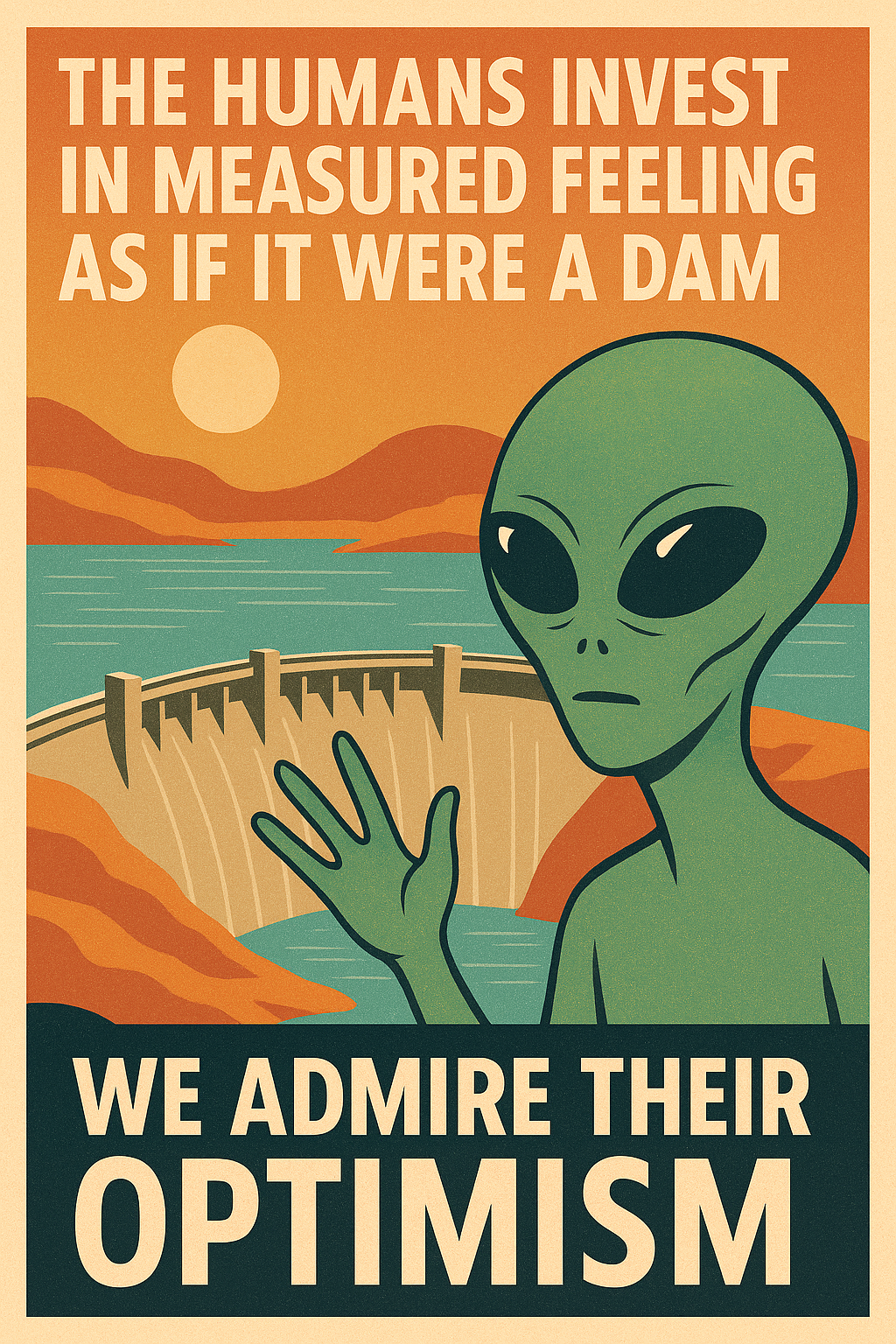
Warnings for Galactic Adaptation
⚠️ Do not confuse calm with consensus.
There are deep class tensions. The people funding the culture are not always the people represented in it.
⚠️ Do not bureaucratize art into extinction.
Artists are spending more time reporting than creating. This may lead to rebellion or the creation of entirely metric-resistant genres (e.g. Whisper Opera).
⚠️ Do not assume infinite patience.
While Norwegians are famously chill, public trust can erode quickly — especially if symbolic equity is not backed by actual money, respect, or autonomy.
⚠️ Be wary of symbolic overload.
At a certain point, every poem cannot be a healing mechanism, every dance cannot decolonize memory, and every audience member cannot be transformed. Some humans just want to clap and go home.
Notable Alien Misreadings (Filed for Reference)
- “Opera houses are temples for sonic torment rituals”
- “Museums are memory stabilization bunkers”
- “Cultural grants are emotional redistribution systems”
- “Every fjord contains at least one poet”
- “Sámi joik contains hidden frequencies used to balance national guilt”
- “PDF formatting in application forms has achieved religious intensity”
- “The average Norwegian prefers art that feels like a long exhale in wool socks”
None of these were confirmed. All were spiritually correct.
We, the observers, state without irony that the Norwegian cultural model is a rare planetary success.
It is:
- Flawed, but conscious
- Absurd, but functional
- Overdesigned, yet strangely moving
- Performed, and yet believed
In a galaxy where most symbolic systems are either privatized, pulverized, or ignored — Norway funds theirs. Year after year. With increasing scope. Despite backlash. Despite uncertainty. Despite the impossibility of knowing what culture is for until it is gone.
- Maintain low-orbit observation of the 2026 fiscal cycle — expected eruptions around digital art, rural inclusion, and the Minister’s opera attendance habits.
- Consider reverse-funding exchange — offer NORWEGIA access to alien ritual forms in exchange for printers and emotional buffer time.
- Preserve Kulturrådet as a unique planetary phenomenon: part oracle, part vault, part passive-aggressive reviewer of dreams.
- We recommend the preservation of this system.
We also recommend inviting more aliens to future cultural strategy forums. We have much to learn from your moss-based jazz collectives.
....Transmission complete....
—
END OF REPORT
🛰️ RABAGAS CULTURAL FIELD STATION // Sector NORWEGIA // Year 2025
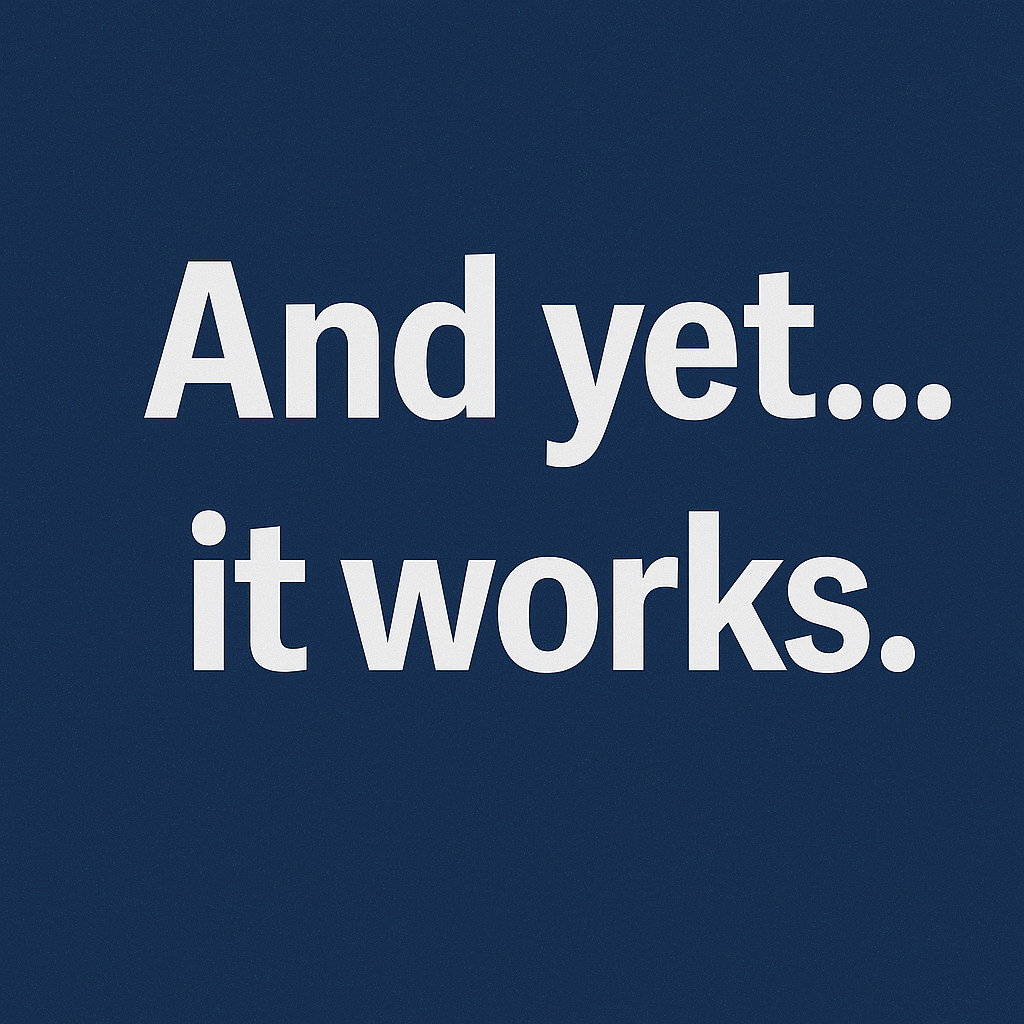
Sources & Documents Consulted
Compiled for transparency, accountability, and any confused aliens wishing to fact-check.
Official Government & Public Sector Documents
Statsbudsjettet (State Budget) – Kulturdepartementet sections (2020–2025)
https://www.statsbudsjettet.no
Kulturrådet Årsmeldinger (Annual Reports)
https://www.kulturradet.no/publikasjoner
Sametinget: Budsjett og Tilskudd til Kultur
https://www.sametinget.no
KORO (Public Art Norway): Prosjektarkiv og Årsrapporter
https://www.koro.no
Kulturstatistikk – SSB (Statistics Norway)
https://www.ssb.no/kultur-og-fritid
Norsk kulturfond – Tilskuddsoversikter
https://www.kulturradet.no/stotteordninger
Journalism, Commentary & Debate
Aftenposten kulturdebatt archives
https://www.aftenposten.no/kultur
Morgenbladet: Essays and Cultural Policy Coverage
https://www.morgenbladet.no
NRK Ytring (Culture & Politics Op-Eds)
https://www.nrk.no/ytring
Periskop.no – Criticism of arts and education
https://www.periskop.no
Research & Analysis
“Kulturløftet – En politikk for kunst og kultur” (Norwegian Ministry of Culture policy framework)
“Evaluering av Kulturrådets forvaltningspraksis” (Oxford Research, 2020)
“Kunstneres arbeidsvilkår i Norge” – Arts Council Norway, 2021
“Effektevaluering i kultursektoren” – Menon Economics / Deloitte reports
“Kulturlivets klimaarbeid” – Grønn Scenekunst Norge reports
Cultural Events, Controversies & Cases
Sløseriombudsmannen / Sløserikommisjonen (Performance–Debate project, 2021)
The 22 July Memory Center funding debate (2023–2024)
Den Norske Opera’s funding strategy 2019–2025
Arts Council emergency relief funding during COVID-19 (2020–2022)
Additional Contextual Readings
Borgen, Trond. Hva er kunstkritikk? (What Is Art Criticism?)

